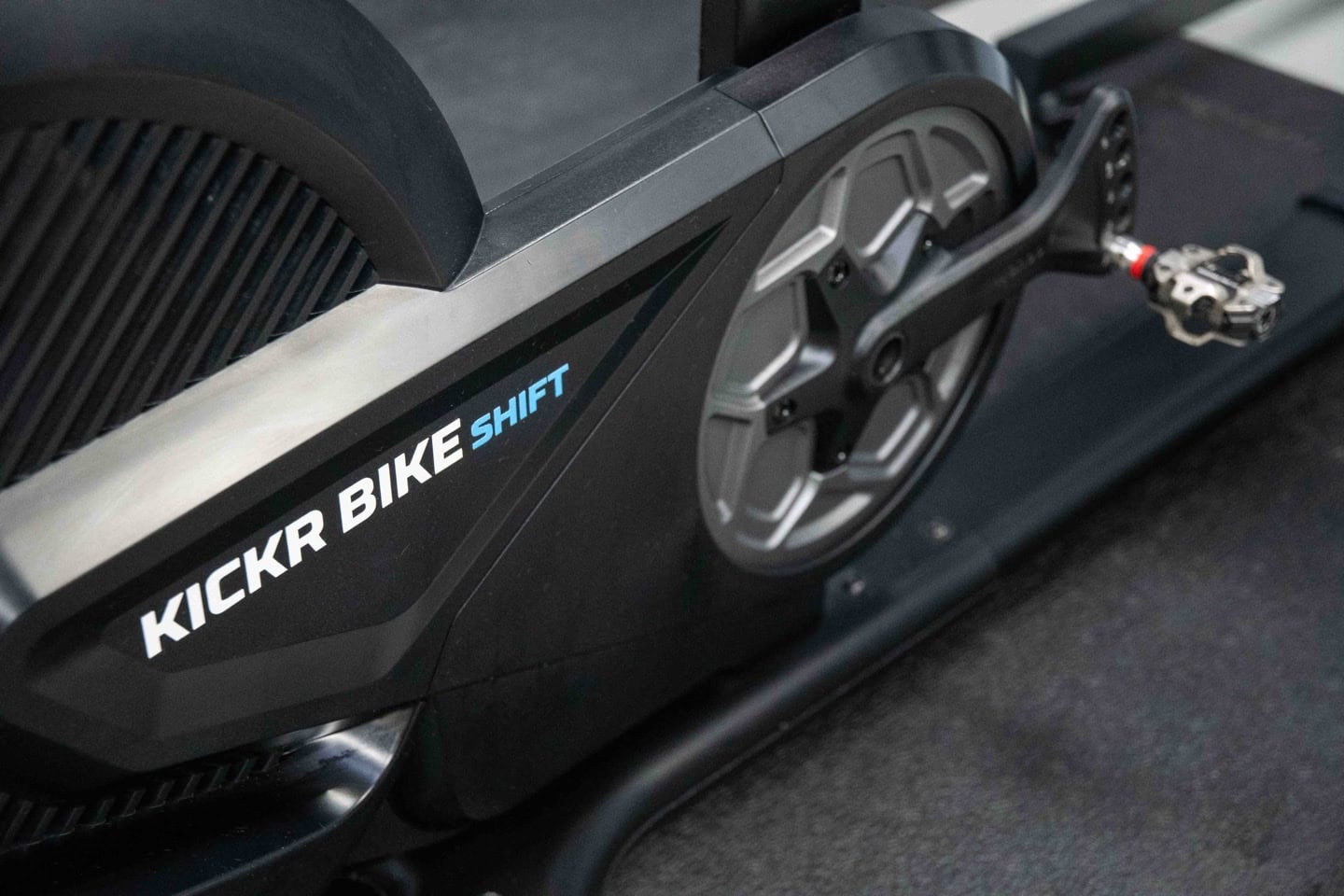 Wahoo KICKR BIKE SHIFT on display
Wahoo KICKR BIKE SHIFT on display
The Wahoo KICKR BIKE SHIFT wasn’t initially planned for a long-term review, but after nine months of consistent use, a comprehensive evaluation is due. This iteration emerges as a streamlined version of the acclaimed Wahoo KICKR BIKE, yet it surprisingly surpasses its predecessor in several key aspects. Notably, the SHIFT operates in near silence, boasts fewer mechanical components prone to wear, and comes at a more accessible price point.
Positioned as a more budget-friendly alternative to the original KICKR BIKE, the SHIFT is priced at $2,999, a notable decrease from the $3,999 tag of its elder sibling. This cost reduction is achieved through strategic hardware modifications. However, after extensive testing, the SHIFT has become the preferred model for many cyclists.
Testing began last fall, even before its official unveiling. Initial hands-on experiences highlighted some power accuracy discrepancies. While these were swiftly addressed via software updates, intermittent accuracy issues persisted for about a month. Fortuitously, subsequent software refinements have eradicated these problems for the past six to seven months. This period of reliable performance justifies a thorough and final review.
Let’s delve into the detailed features and performance of the Wahoo KICKR BIKE SHIFT.
Decoding the Differences: KICKR BIKE SHIFT vs. KICKR BIKE V2
 Side-by-side comparison of KICKR BIKE SHIFT and KICKR BIKE V2
Side-by-side comparison of KICKR BIKE SHIFT and KICKR BIKE V2
While sharing a name with the KICKR BIKE V1/V2, the KICKR BIKE SHIFT represents a significant technological departure. From frame architecture and materials to the flywheel and drivetrain mechanism, and even the electronic shifter interfaces, almost every element is redesigned. Shared components are limited to the saddle itself (though even its attachment method differs) and the handlebars (with a revised connection system).
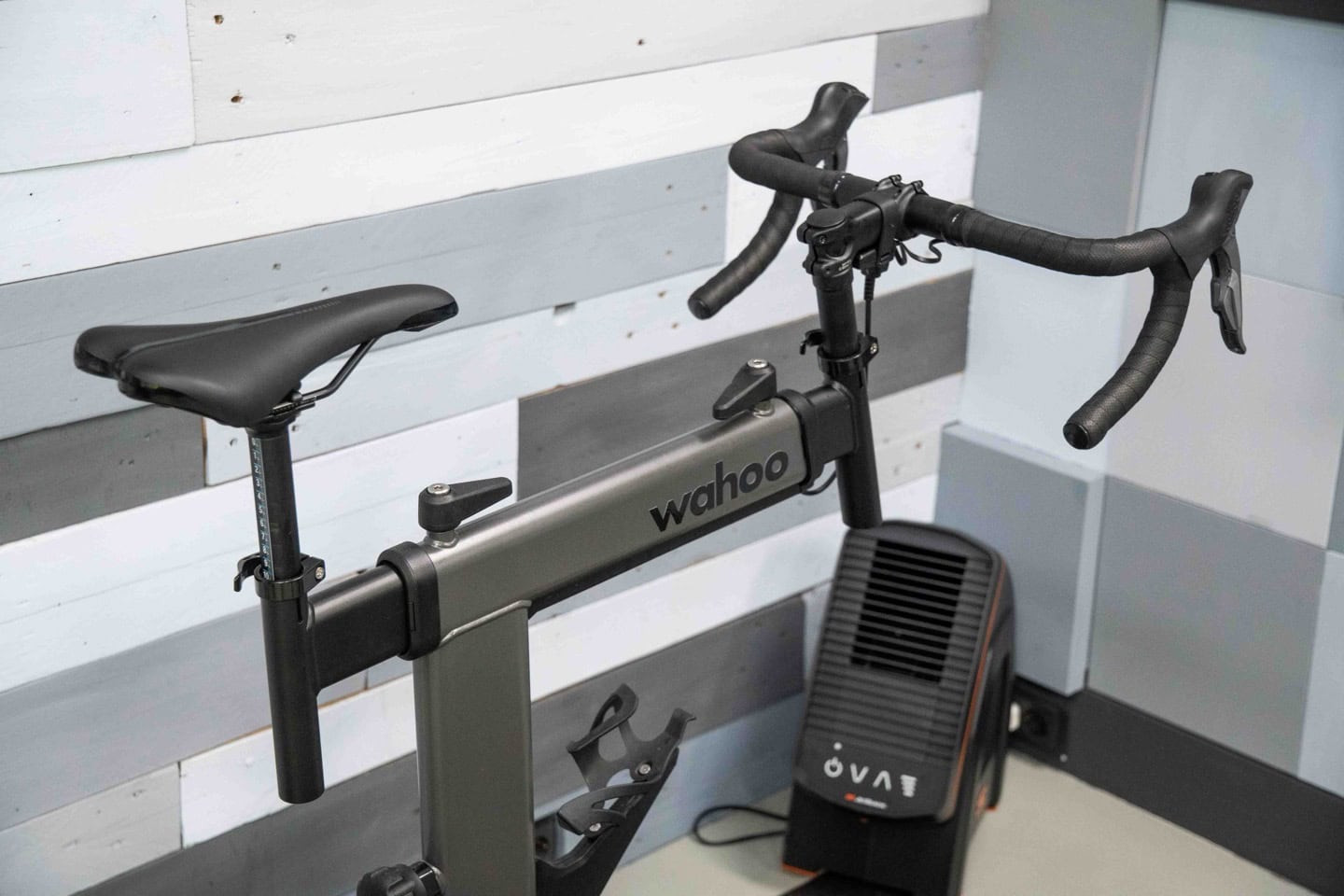 Close-up of the thinner frame design of the KICKR BIKE SHIFT
Close-up of the thinner frame design of the KICKR BIKE SHIFT
Starting with structural distinctions, the KICKR BIKE SHIFT, often informally called KICKR Bike Jr., features noticeably slimmer framework components. This design choice serves multiple purposes, including weight reduction for decreased shipping costs and material savings, but crucially, it enhances rider ergonomics. A frequent criticism of the original KICKR BIKE V1/V2 was its wide top-tube, which often caused thigh chafing, depending on individual bike fit. The SHIFT’s leaner frame mitigates this issue entirely, offering a more comfortable experience.
The SHIFT also introduces newly designed adjustment handles tailored to its slender structure. These handles function effectively, neither superior nor inferior to the previous design, simply different. Personal experience with both the KICKR BIKE V1 at home and the KICKR BIKE SHIFT in an office setting reveals no significant preference for either handle style.
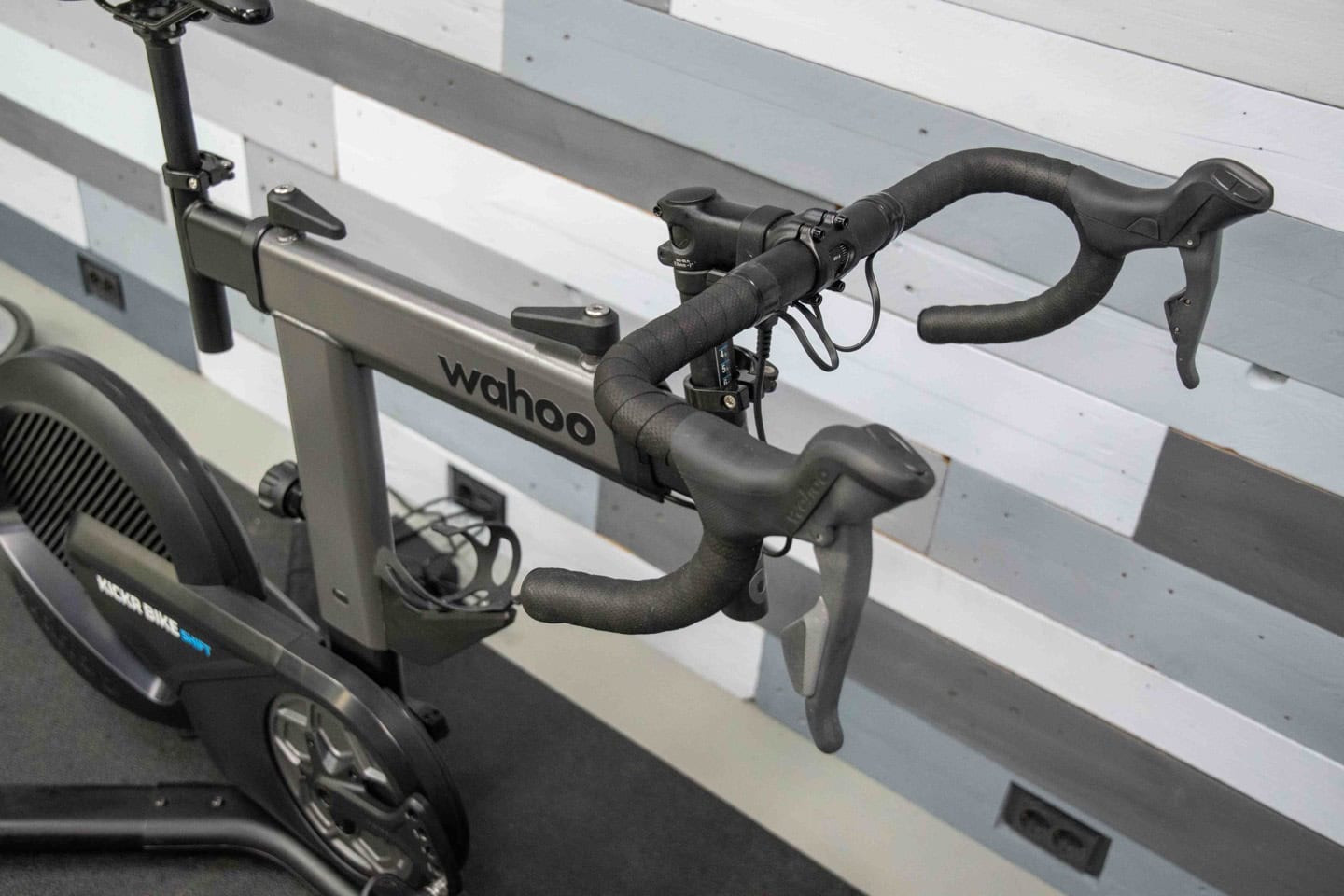 Detail of the seat post clamp on the Wahoo KICKR BIKE SHIFT
Detail of the seat post clamp on the Wahoo KICKR BIKE SHIFT
Another significant improvement is the updated seat post clamp, now featuring a hex-compatible nut. This allows for secure tightening with a hex wrench, ensuring steadfast saddle positioning. This enhanced clamp effectively eliminates slippage, even under rigorous use. In contrast, the KICKR BIKE V2, while equipped with a hand-friendly clamp, is more susceptible to seat post slippage.
Below, the KICKR BIKE V2 clamp is shown on the left, and the KICKR BIKE SHIFT clamp on the right:
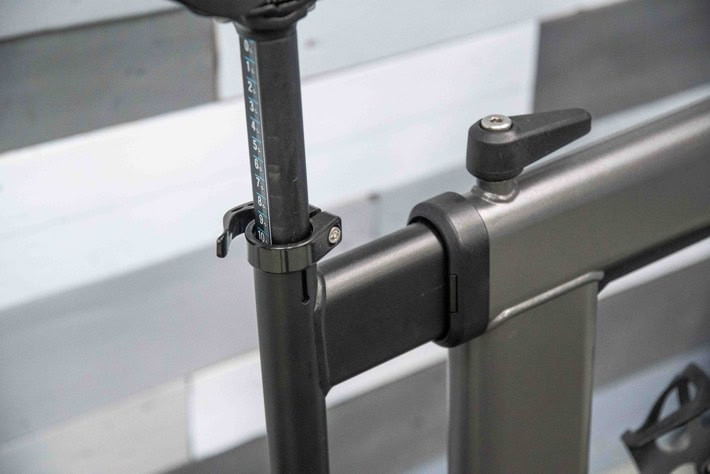 Seat post clamp of KICKR BIKE SHIFT
Seat post clamp of KICKR BIKE SHIFT
Regarding fit and sizing, while the markings on the KICKR BIKE V1/V2 and KICKR BIKE SHIFT are broadly similar, minor discrepancies of a few millimeters exist. However, the Wahoo app intelligently compensates for these variations. By inputting bike fit coordinates from professional systems or personal measurements, the app generates precise marking guidance specific to the KICKR BIKE SHIFT model.
Moving to electronic components, the front of the SHIFT benefits from a cleaner aesthetic with reduced cable clutter. The previous generation’s complex wiring is replaced by a streamlined, magnetically attached junction box reminiscent of Di2/AXS systems. This unit neatly houses shifter cable connections, power conduits, and status LEDs for wireless communication.
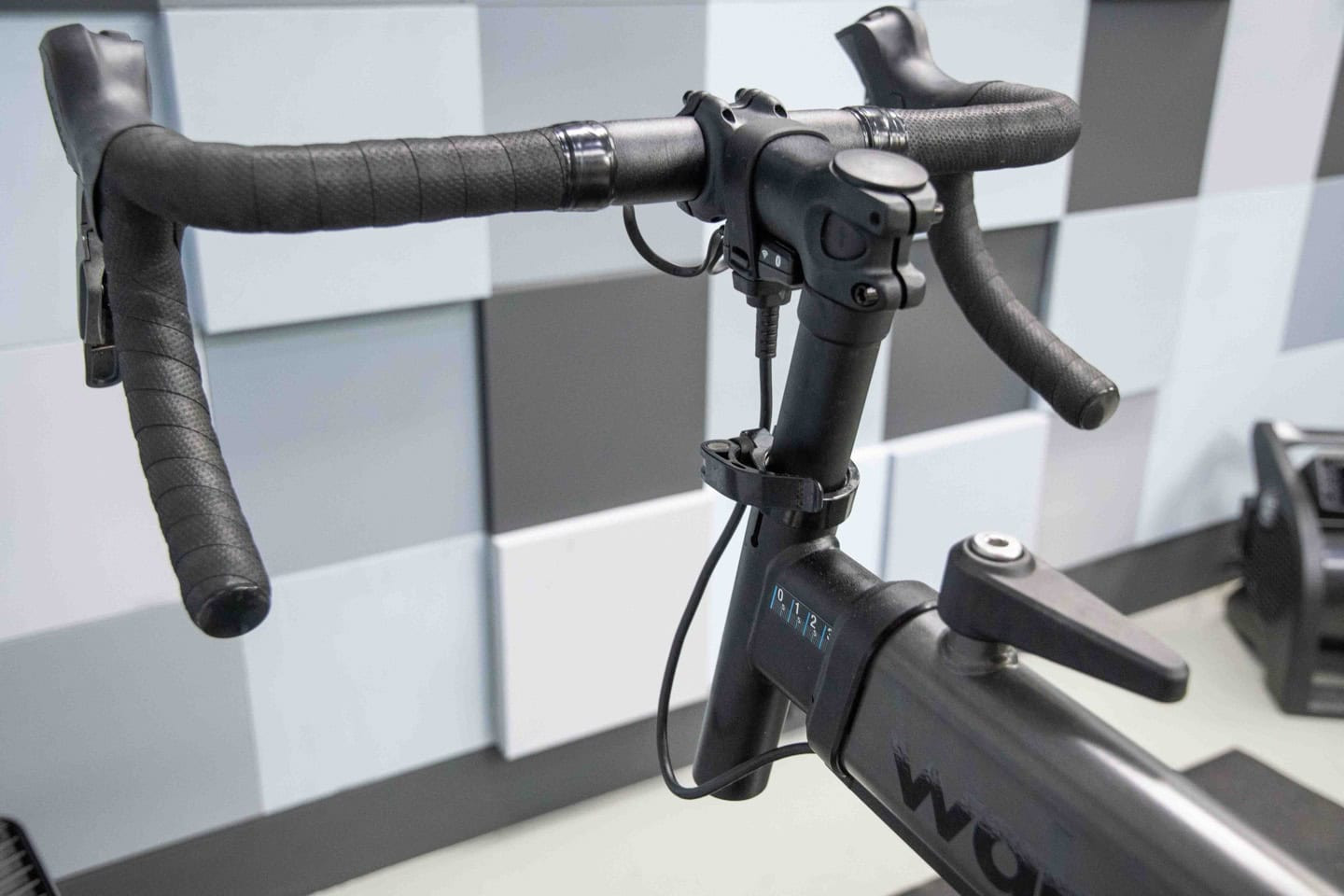 Magnetic junction box on the handlebar of the KICKR BIKE SHIFT
Magnetic junction box on the handlebar of the KICKR BIKE SHIFT
Despite initial concerns about the magnetic attachment’s robustness, it has proven exceptionally secure throughout testing. Accidental disconnections during rides, whether from bumps or contact, have not occurred, demonstrating the system’s reliability.
At the rear, the KICKR BIKE SHIFT introduces a completely redesigned drivetrain and flywheel system. Unlike the motor-driven electromagnetic system of the KICKR BIKE V1/V2, the SHIFT employs a system more akin to Wahoo KICKR trainers. This new drivetrain cannot simulate downhill momentum or coasting speeds. Visually, the design presents a sleek, all-black appearance, with any perceived “white” or reflective areas being merely studio light reflections.
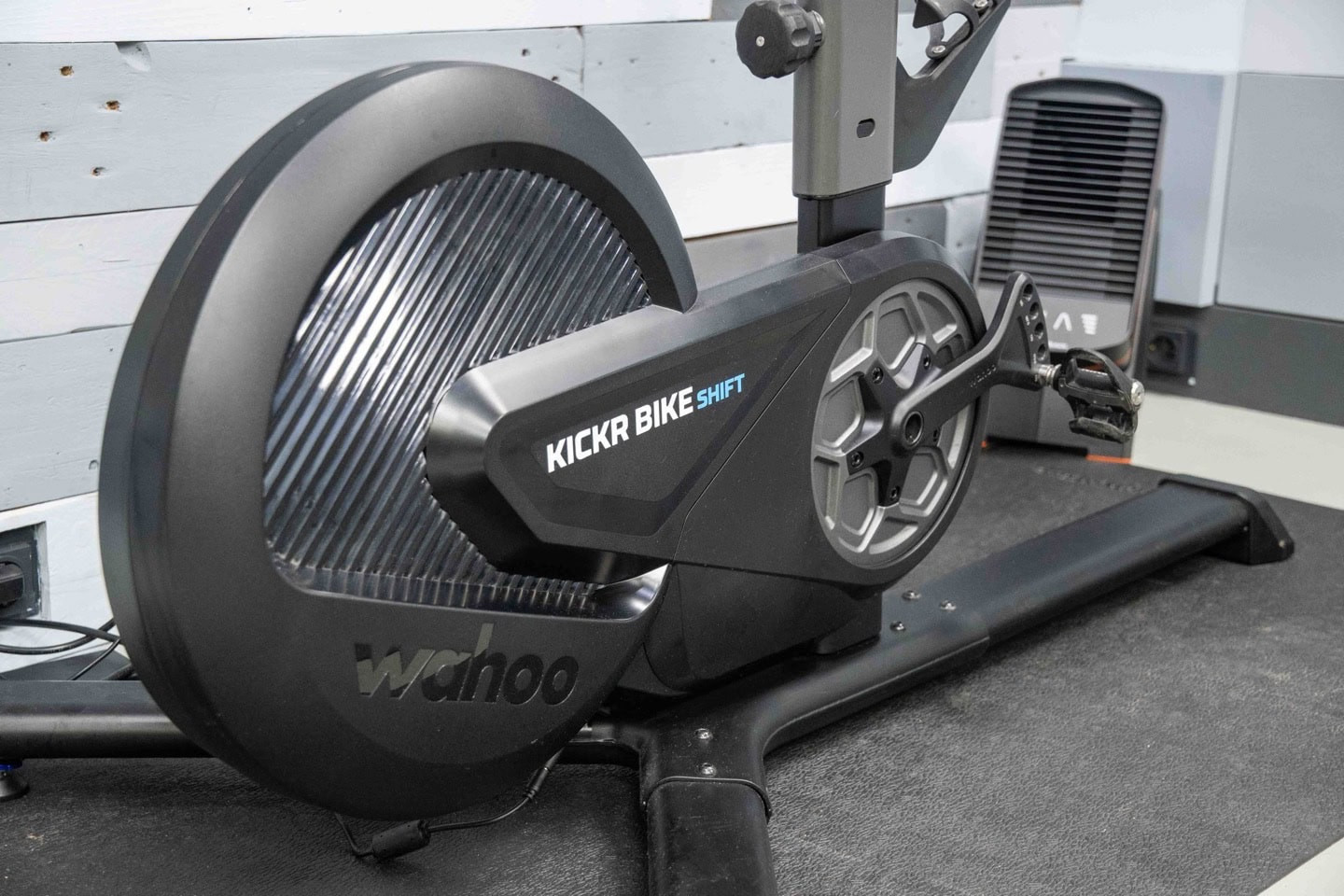 Rear view of the Wahoo KICKR BIKE SHIFT drivetrain
Rear view of the Wahoo KICKR BIKE SHIFT drivetrain
This revised drivetrain system operates in complete silence, eliminating any noise during pedaling or coasting. This starkly contrasts with the KICKR BIKE V1 and V2, which are notably louder.
The absence of built-in KICKR CLIMB gradient simulation further contributes to the SHIFT’s mechanical simplicity and quiet operation. Without complex elevation mechanisms or pivot points, the SHIFT achieves remarkable silence, comparable to a Peloton Bike. This is a significant advantage over the KICKR BIKE V1 and V2, known for becoming progressively noisier over time.
One immediate observation is the absence of a physical gearing display on the KICKR BIKE SHIFT, a feature present on the KICKR BIKE V1/V2. This omission is particularly noticeable within Zwift, as the platform does not natively display gear selection for Wahoo Bikes (unlike Tacx NEO Bike and Wattbike).
While Zwift and Wahoo acknowledged this limitation nearly a year prior and indicated a fix was forthcoming, it remains unresolved. Current updates suggest Zwift is developing new protocol integrations to enable gear display for trainers, with several companies currently testing this feature. However, the delay in implementing this basic functionality is considerable.
Finally, key technical specifications of the KICKR BIKE SHIFT include:
- Power Accuracy: +/- 1%
- Maximum Simulated Incline: 20%
- Maximum Supported Resistance: 2,200w
- Zero-Calibration: Software algorithm
- Connectivity: Dual ANT+/Bluetooth Smart, ANT+ FE-C, power/speed/cadence broadcasting
- Built-in WiFi: 2.4 GHz
- Direct Connect: Retains wired port option (adapter required)
- Bike Weight: 100lbs/40kgs
- Max Rider Weight: 250lbs/113.4kgs
- Power Requirement: Plug-in operation
- KICKR Race Mode: Not included
Unboxing and Setup: Ready to Ride Quickly
 Wahoo KICKR Bike SHIFT box
Wahoo KICKR Bike SHIFT box
Setting up the KICKR BIKE SHIFT is straightforward and efficient. The main components – frame, legs, seat post, and handlebars – are easily assembled. Pedal installation is also a simple step.
The initial step involves attaching the three legs to the main frame, securing them with bolts to establish a stable base.
 Attaching legs to the KICKR BIKE SHIFT frame
Attaching legs to the KICKR BIKE SHIFT frame
Next, choose to install either the seat post or handlebars. While the manual provides guidance on the optimal sequence, either can be inserted into the designated slot and secured by tightening a lever.
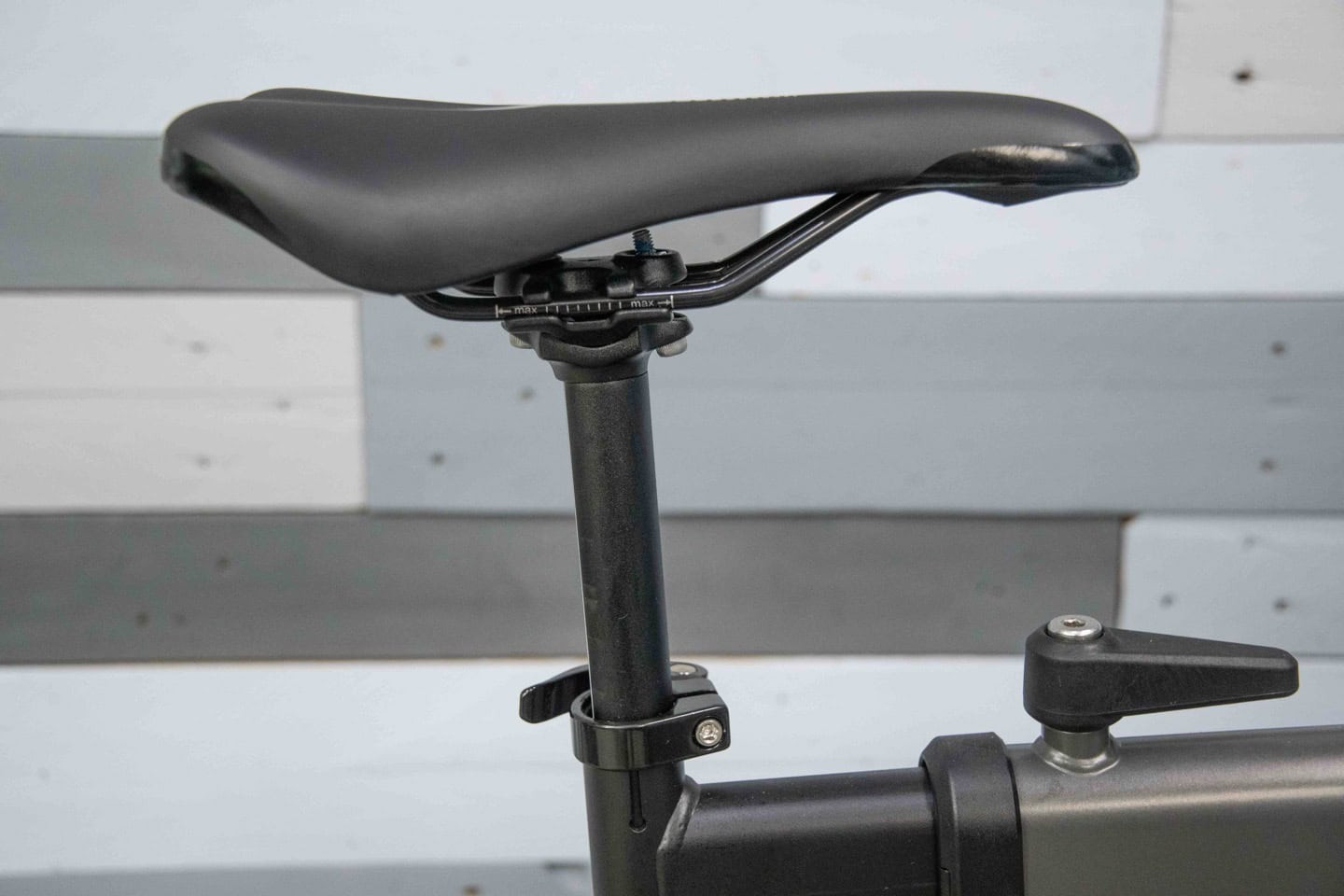 Installing the seat post on the KICKR BIKE SHIFT
Installing the seat post on the KICKR BIKE SHIFT
Repeat the process for the remaining component – insert into the slot and tighten the lever. Both the seat post and handlebar offer adjustable settings to accommodate various rider sizes.
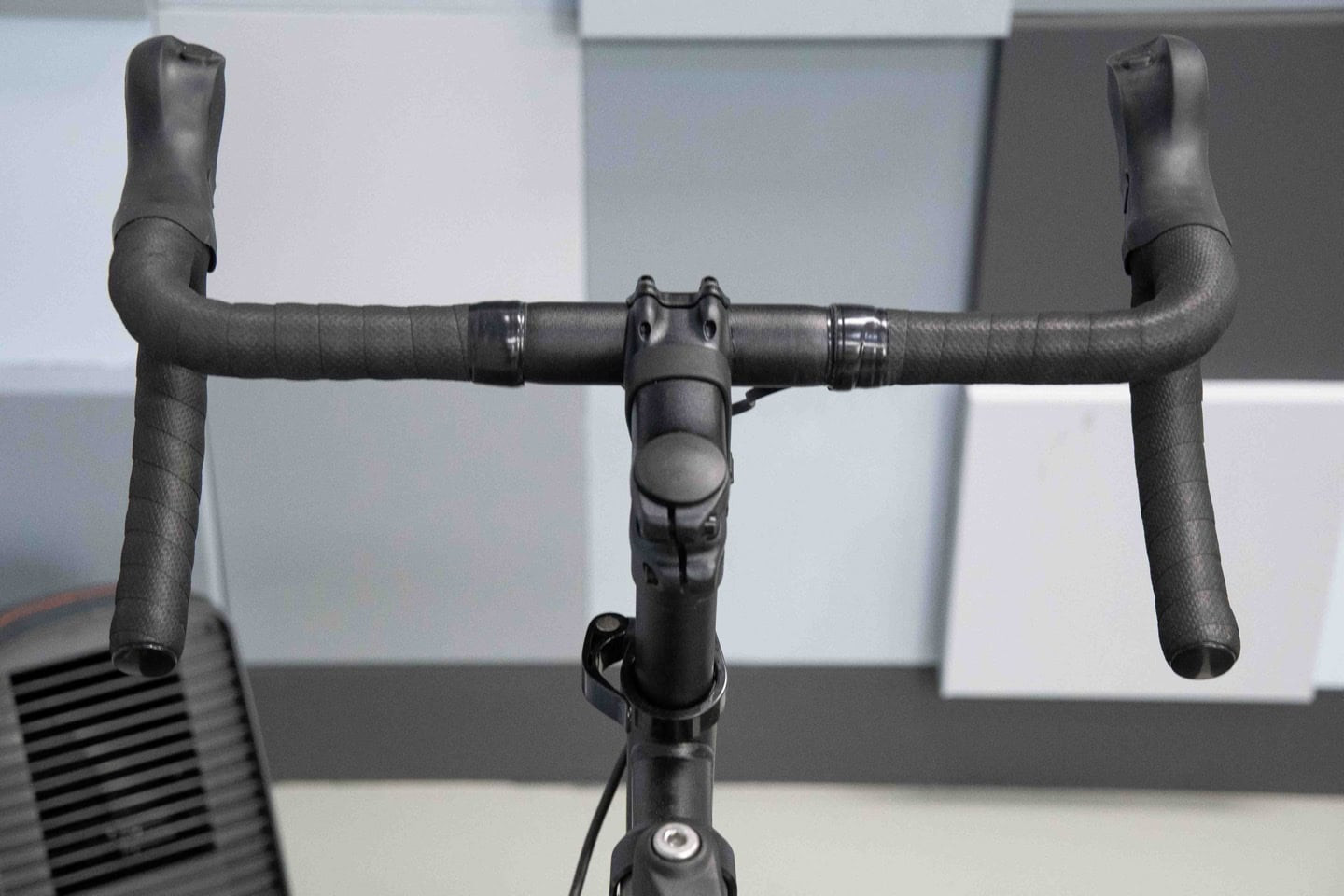 Installing the handlebars on the Wahoo KICKR BIKE SHIFT
Installing the handlebars on the Wahoo KICKR BIKE SHIFT
For the handlebars, connect the small magnetic cable, which powers the handlebar electronics and bike connectivity. This cable routes from the rear of the bike, past the resistance unit, and up to the handlebars via the magnetic mount system.
 Close-up of the magnetic cable connection
Close-up of the magnetic cable connection
Then, connect the power supply to the rear of the bike, just below the flywheel, and plug the other end into a power outlet.
Finally, attach your preferred pedals, selecting the appropriate crank length holes. The next section details crank length options.
With these steps completed, the Wahoo bike is ready for your first ride.
Optimizing Bike and Rider Fit on Your Wahoo Bike
 Rider adjusting the fit on the KICKR BIKE SHIFT
Rider adjusting the fit on the KICKR BIKE SHIFT
A primary benefit of indoor smart bikes is their adaptability for multiple users within a household. Adjustability for diverse rider sizes and the ease of switching between setups are crucial. If adjustments are cumbersome, the bike’s usability diminishes.
Wahoo has refined the adjustment handles on the SHIFT compared to the higher-end KICKR Bike, opting for more user-friendly, traditional indoor bike levers. This design choice prioritizes functionality over aesthetics.
The KICKR BIKE SHIFT offers six core adjustment points:
- Saddle height (vertical adjustment)
- Saddle position (fore/aft and saddle angle)
- Handlebar height (vertical adjustment)
- Handlebar position (fore/aft)
- Stand-over height adjustment (vertical adjustment)
- Crank length
Saddle height is a combination of stand-over height and saddle post extension.
Each adjustment point features a marked ruler, simplifying the process of recording and recalling precise settings for different riders.
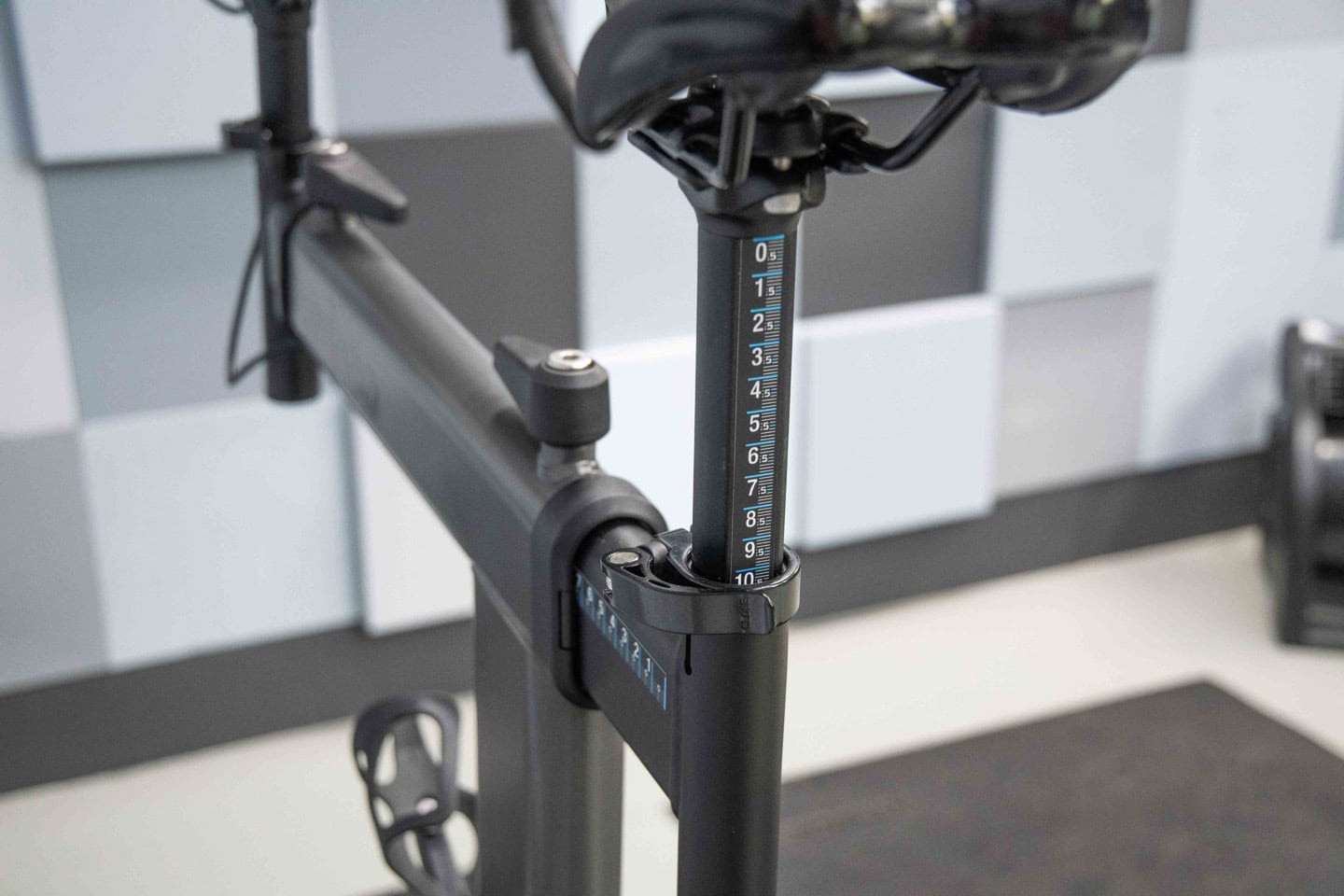 Measurement markings on the KICKR BIKE SHIFT frame
Measurement markings on the KICKR BIKE SHIFT frame
The adjustment clamps are designed to rotate freely when popped open, ensuring they remain clear of your legs during rides.
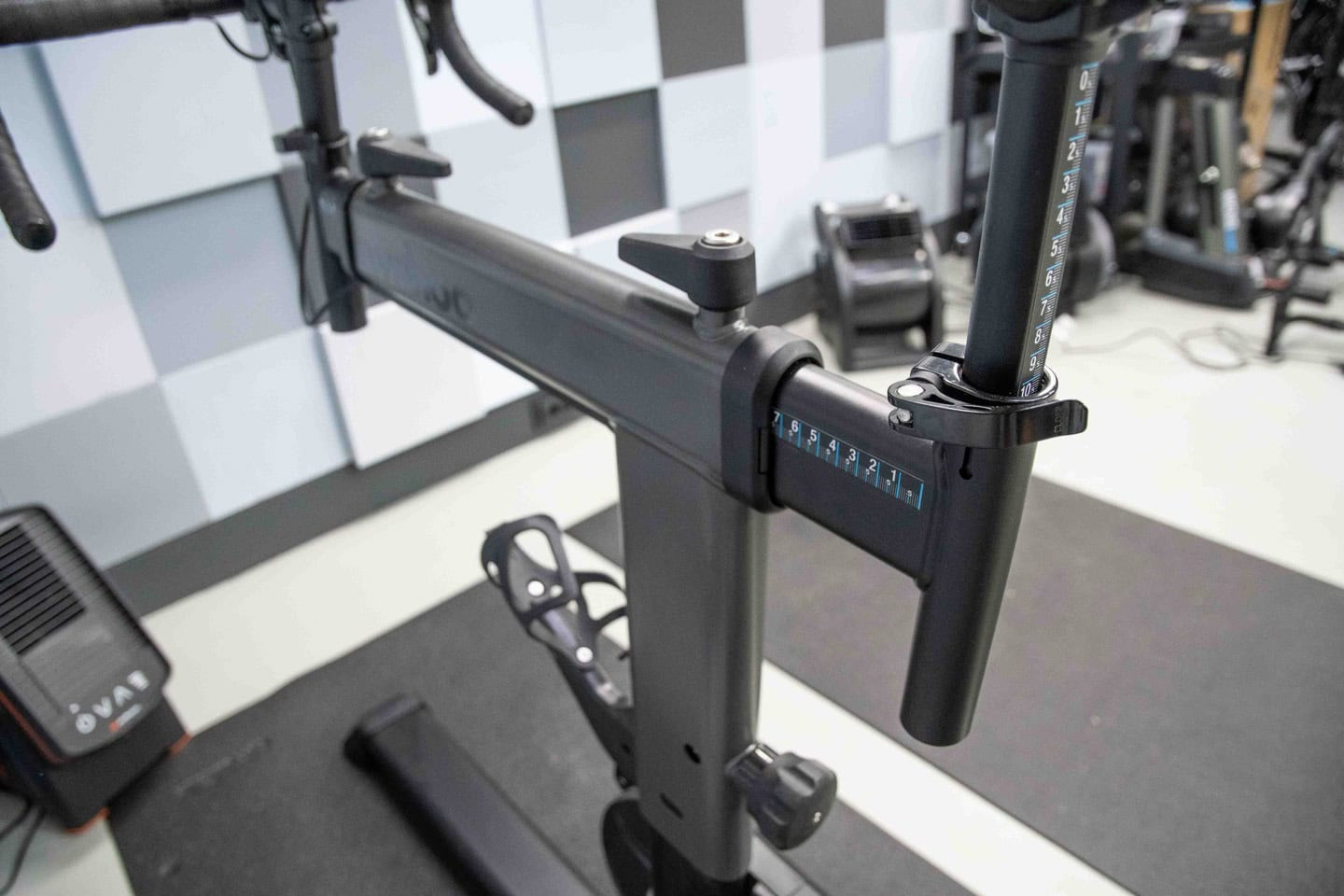 Open adjustment clamp on the Wahoo bike
Open adjustment clamp on the Wahoo bike
Wahoo has addressed seat post slippage issues on the SHIFT with a redesigned clamp that accommodates tool-tightening. This modification largely resolves the slippage concerns.
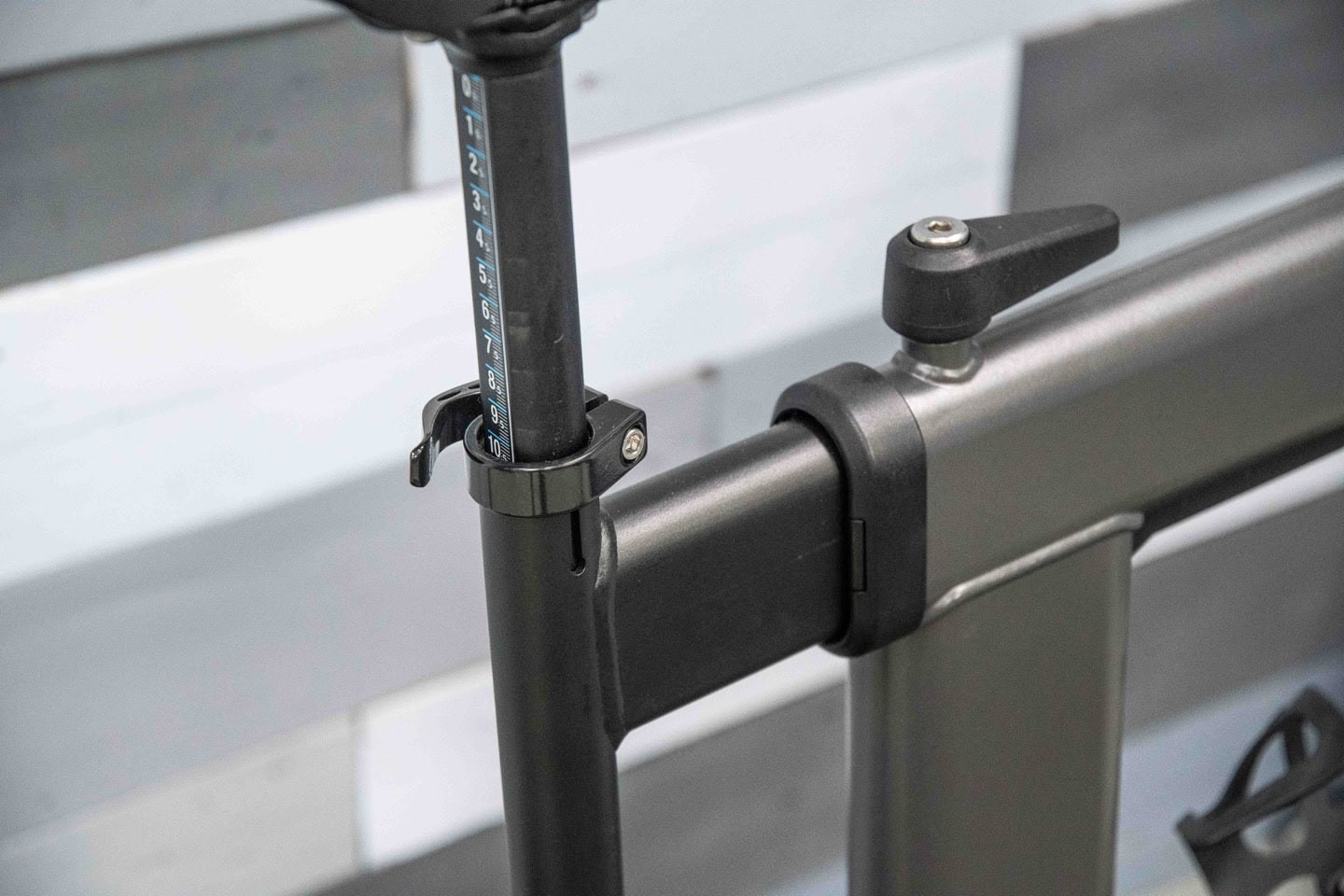 Seat post clamp requiring a hex wrench for tightening
Seat post clamp requiring a hex wrench for tightening
However, Wahoo’s continued use of a non-round seat post is a point of consideration. While potentially chosen for aesthetic reasons, it can contribute to slippage unless firmly tightened. A simple solution is to replace it with a standard round seat post and saddle, a modification commonly adopted on older KICKR BIKE V1 models.
To streamline bike fit, the Wahoo app includes a guided setup system with two options:
A) Input height, inseam, and preferred riding position (relaxed, endurance, race) to receive KICKR BIKE SHIFT measurements.
B) Utilize measurements from professional bike fit systems like GURU Fit System, Retul Fit, or Trek Precision Fit to obtain SHIFT-compatible settings.
The app interface is intuitive, providing measurements both as numerals on the bike’s rulers and as alphanumeric codes for stand-over height. The new Wahoo app version appears to have removed the feature to estimate fit coordinates from bike photographs.
A notable ergonomic improvement of the KICKR BIKE SHIFT is its slimmer top tube profile. The wider top tube on previous KICKR BIKE models often led to thigh rubbing, making it the widest among comparable indoor bikes in the leg-contact area. The Tacx Bike avoids this issue through its top tube design.
Crank length adjustability is another key feature. The Wahoo system employs a bear-claw design, allowing pedals to be installed in various crank length holes. Supported lengths include 165, 167.5, 170, 172.5, and 175mm. The Wahoo app assists in selecting the appropriate crank arm length if needed.
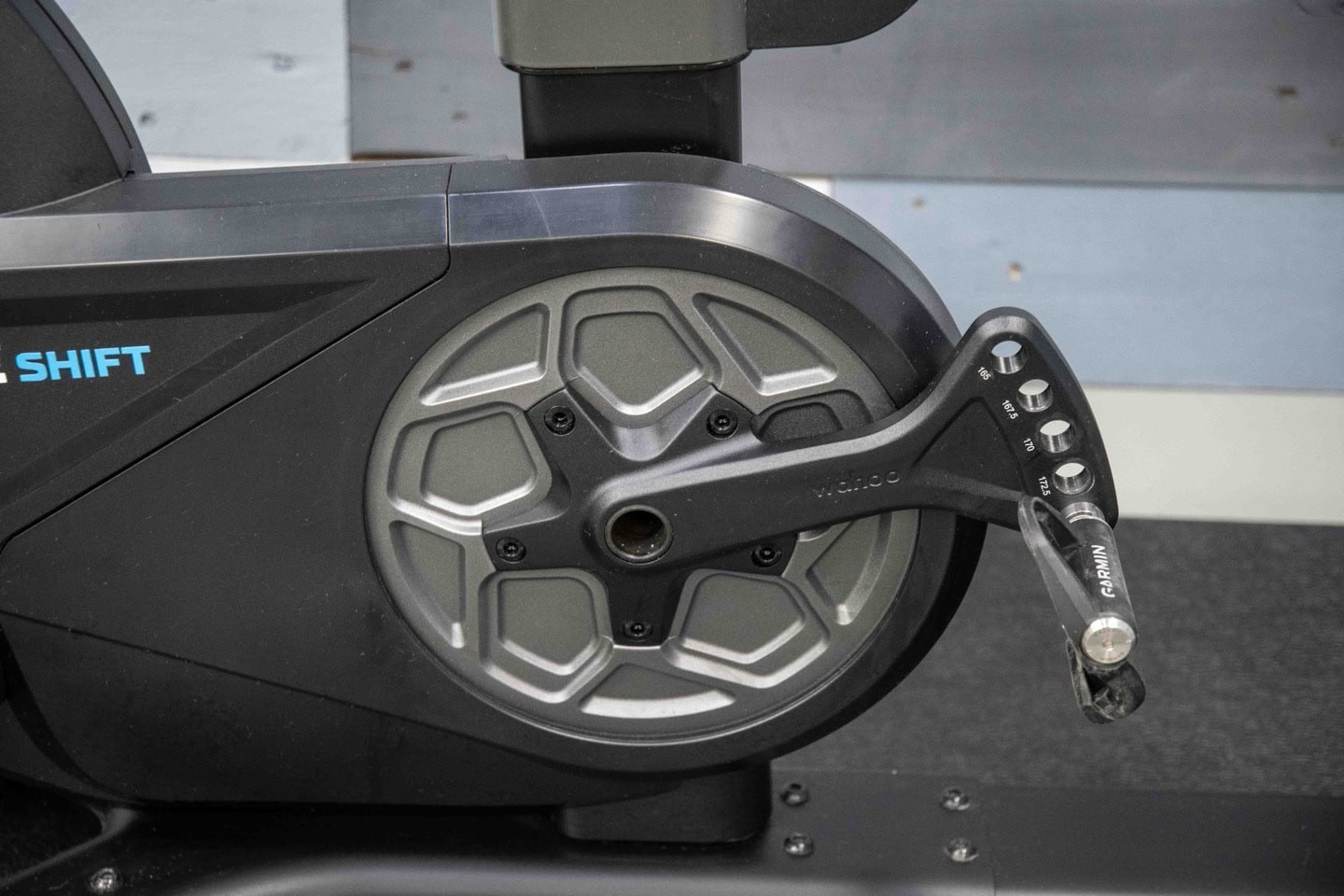 Crank arm with multiple pedal holes for length adjustment
Crank arm with multiple pedal holes for length adjustment
The crank length adjustment mechanism on the KICKR BIKE SHIFT is simplified for durability compared to earlier, more stylized iterations, likely addressing breakage issues reported by some users.
Triathletes will appreciate that the KICKR BIKE SHIFT’s standard handlebars are compatible with clamp-on aero bars. While not tested on the SHIFT, aero bars are used on a KICKR BIKE V1, as shown below:
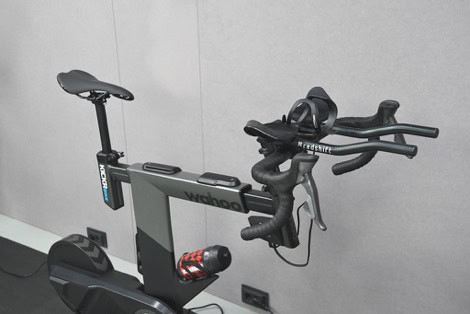 KICKR BIKE V1 with clamp-on aero bars
KICKR BIKE V1 with clamp-on aero bars
However, neither KICKR Bike model includes remote shifters, so gear changes with aero bars still require reaching the handlebar shifters.
The Riding Experience: Immersive and Responsive
 Rider in action on the Wahoo KICKR Bike SHIFT
Rider in action on the Wahoo KICKR Bike SHIFT
Let’s explore the daily riding dynamics of the KICKR BIKE SHIFT, focusing on subjective aspects like road feel and movement, alongside essential logistical elements. Technical details on protocols are covered in the App Compatibility section.
Pairing with popular training applications is seamless. For Zwift, the most widely used platform, connect the SHIFT as a power source, resistance trainer, cadence sensor, and steering controller.
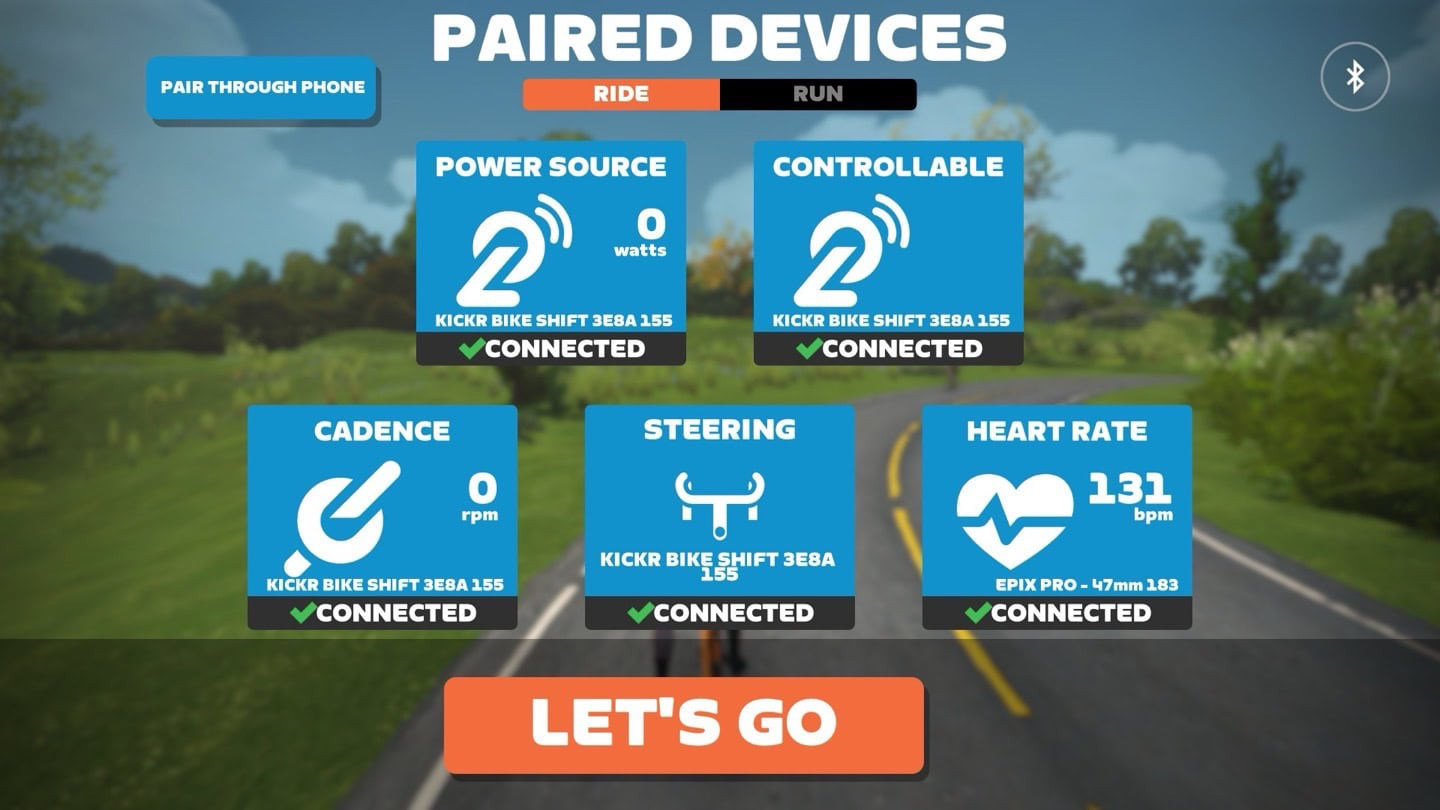 Pairing screen in Zwift showing KICKR BIKE SHIFT connection options
Pairing screen in Zwift showing KICKR BIKE SHIFT connection options
Before diving into your virtual ride, access the Wahoo Fitness app to customize shifting preferences. The KICKR BIKE SHIFT allows configuration for three distinct shifting styles:
A) Sequential
B) Shimano (Di2 emulation)
C) SRAM (AXS/eTAP emulation)
Within these, you can create specific bike gearing profiles, choosing from common chainring and cassette combinations or setting up custom configurations.
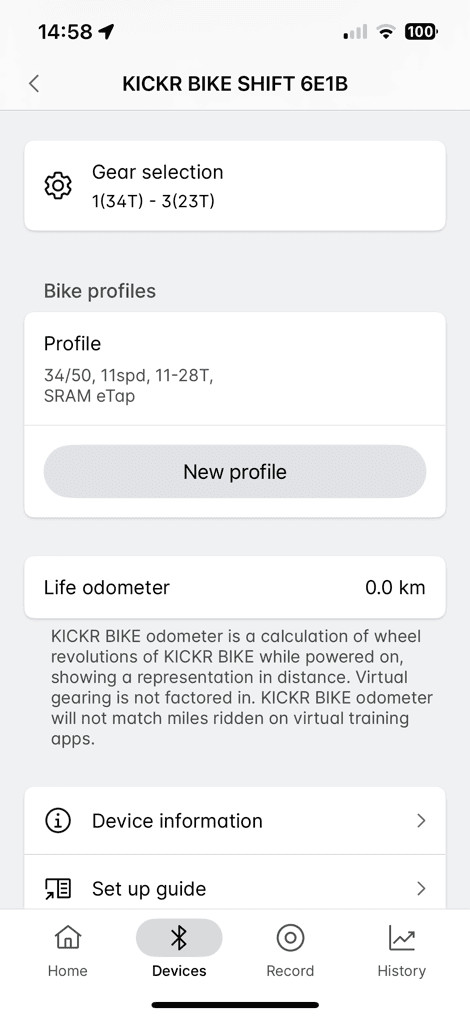 Gearing customization options in the Wahoo Fitness app
Gearing customization options in the Wahoo Fitness app
Multiple bike and rider profiles can be saved. However, remember to switch profiles in the Wahoo app before starting a session in Zwift or other applications. Ideally, these apps would offer in-game profile selection, eliminating the need for pre-ride adjustments in the Wahoo app. IndieVelo offers a step in this direction, allowing in-ride shifting and gearing adjustments.
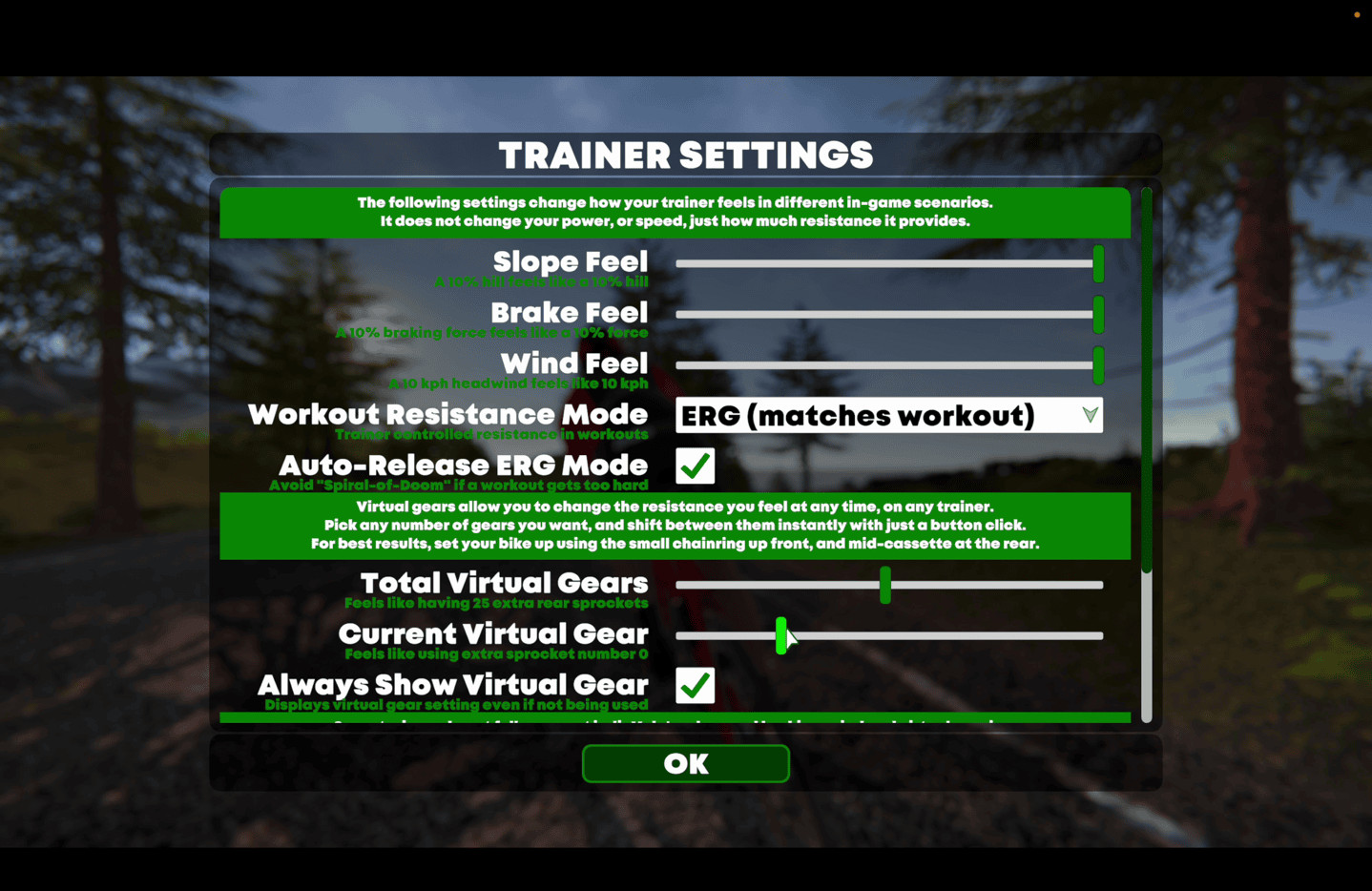 Gearing adjustments within IndieVelo interface
Gearing adjustments within IndieVelo interface
With setup complete, begin your virtual cycling journey. In Zwift’s simulation mode (SIM mode), the KICKR BIKE SHIFT dynamically adjusts resistance to replicate route gradients, such as a 5% incline. The intensity of this simulation is influenced by the ‘Trainer Difficulty’ setting in Zwift, which defaults to 50%, effectively halving the perceived gradient unless adjusted.
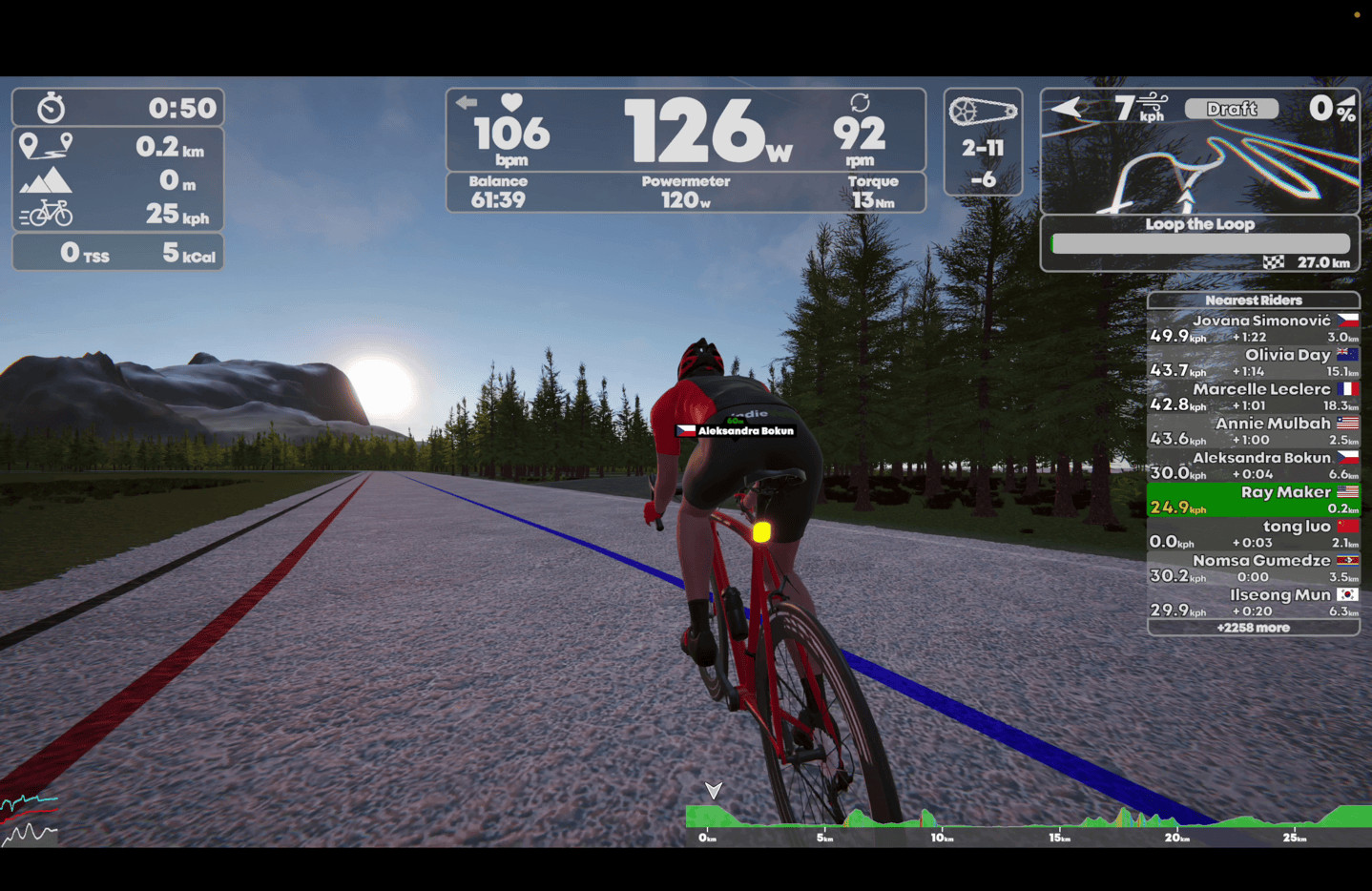 Zwift interface in simulation mode with KICKR BIKE SHIFT connected
Zwift interface in simulation mode with KICKR BIKE SHIFT connected
Unlike the KICKR BIKE V1 & V2, the SHIFT does not physically tilt to simulate inclines and declines. While dynamic tilt is an engaging feature, its practical usage among KICKR Bike owners is varied. Many users, including this reviewer, often forget to enable it before rides. However, some riders highly value this feature.
In terms of “road-like” feel, the KICKR BIKE SHIFT performs admirably. Acceleration and deceleration feel realistic, and sprints feel genuine. This is noteworthy given its different technology compared to the KICKR BIKE V1 & V2. The SHIFT uses a system similar to Wahoo KICKR smart trainers, whereas the V1/V2 use an electromagnetic system like Tacx NEO devices. The primary difference manifests during descents. The KICKR Bike V1/V2 motorizes the flywheel to simulate downhill momentum, while the SHIFT’s flywheel gradually stops when pedaling ceases, similar to flat ground.
Again, the absence of downhill drive might be unnoticed by those unfamiliar with it. However, experienced users may or may not miss this feature, depending on personal preferences.
ERG mode is available for structured workouts, where the SHIFT precisely controls wattage according to workout protocols. The bike maintains consistent wattage targets, with minor second-to-second fluctuations, as demonstrated in this Indievelo ERG mode session:
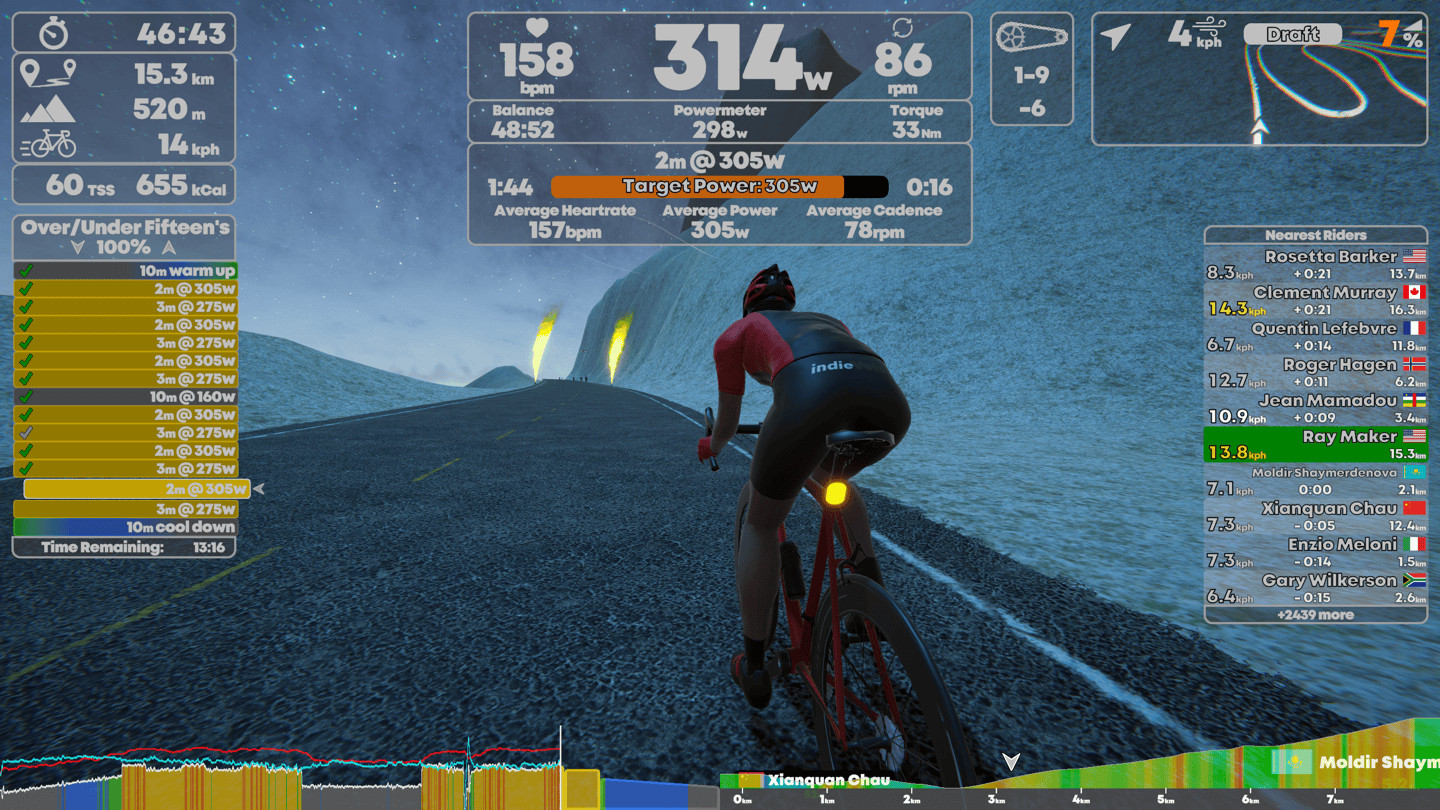 ERG mode workout display in IndieVelo with KICKR BIKE SHIFT
ERG mode workout display in IndieVelo with KICKR BIKE SHIFT
Regarding noise, the KICKR BIKE SHIFT is remarkably quiet, a significant advantage over the noisier KICKR BIKE V1/V2 models. The V2 is quieter than the V1, especially over time, but both are considerably louder than the SHIFT, which operates almost silently. A prior noise test highlights this difference:
 YouTube video thumbnail for KICKR BIKE SHIFT noise test
YouTube video thumbnail for KICKR BIKE SHIFT noise test
The handlebar shifters and brakes on the KICKR BIKE SHIFT are well-designed and feel authentic, mimicking real bike components rather than gamified buttons. This tactile feedback enhances the immersive cycling experience.
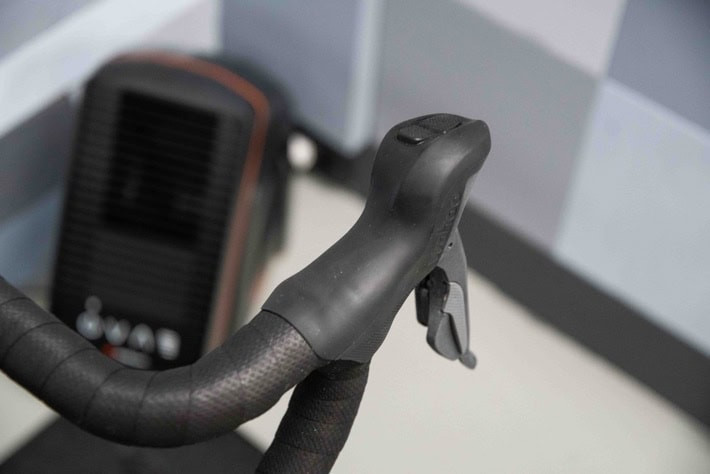 Close-up of the left shifter on the KICKR BIKE SHIFT
Close-up of the left shifter on the KICKR BIKE SHIFT
The shifters provide a distinct “click” sensation, mirroring real bike shifting. As mentioned, Shimano and SRAM shifting styles can be emulated. The integrated brakes function in most games to decelerate your avatar.
For games with steering support, the inner buttons on each shifter control directional movement within designated lanes.
Regarding physical movement, the KICKR BIKE SHIFT lacks rocker-plate functionality. It does not offer the same degree of motion as trainers like the KICKR MOVE or setups with rocker plates. However, the frame design allows for a subtle degree of sway, which is generally sufficient and not distracting.
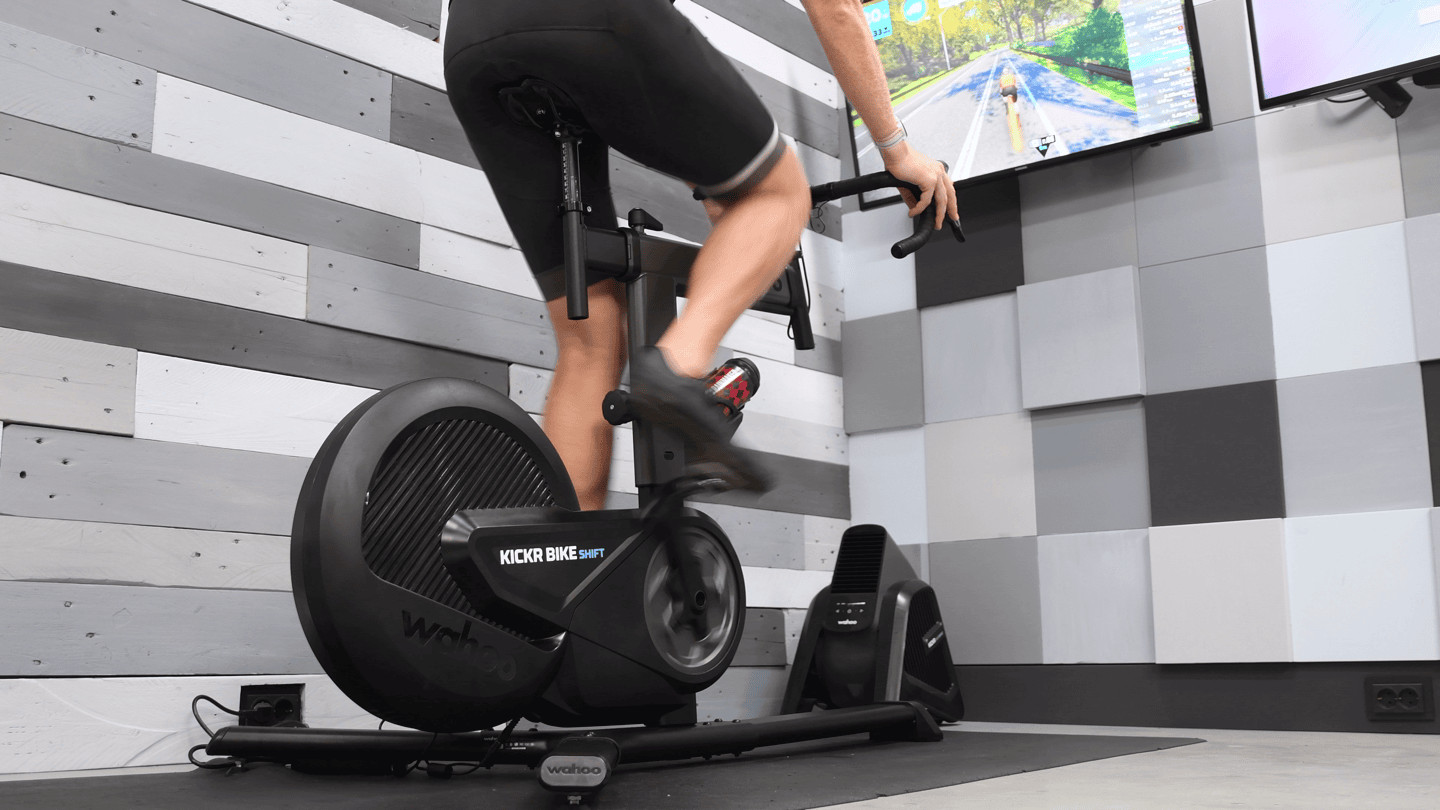 Side view of the KICKR BIKE SHIFT showing its stable stance
Side view of the KICKR BIKE SHIFT showing its stable stance
Stability is excellent, even for taller riders. The KICKR BIKE SHIFT is unlikely to tip over during normal riding conditions, demonstrating a secure and balanced design.
App Compatibility: Seamless Integration
The Wahoo KICKR BIKE SHIFT adheres to industry standards for interoperability, ensuring broad compatibility with cycling applications. Platforms like Zwift, TrainerRoad, Indievelo, Rouvy, FulGaz, Kinomap, and many others readily support these standards.
Specifically, the KICKR BIKE SHIFT supports these protocol transmission standards:
ANT+ FE-C Trainer Control: For controlling the KICKR BIKE SHIFT via ANT+ from apps and head units.
ANT+ Power Meter Broadcast: Broadcasts power data as an ANT+ power meter, useful for recording data independently of resistance control.
Bluetooth Smart FTMS: For Bluetooth control from apps like Zwift.
Bluetooth Smart Power Meter Broadcast: Broadcasts power data via Bluetooth, primarily for Bluetooth-only devices like Apple Watch or Polar/Suunto watches.
WiFi Direct Connect: Built-in WiFi for direct game connectivity and firmware updates.
Ethernet Direct Connect (with adapter): Wired network connectivity option via a Wahoo adapter.
Cadence data is integrated into all connection streams. When pairing with apps, the cadence channel is automatically included:
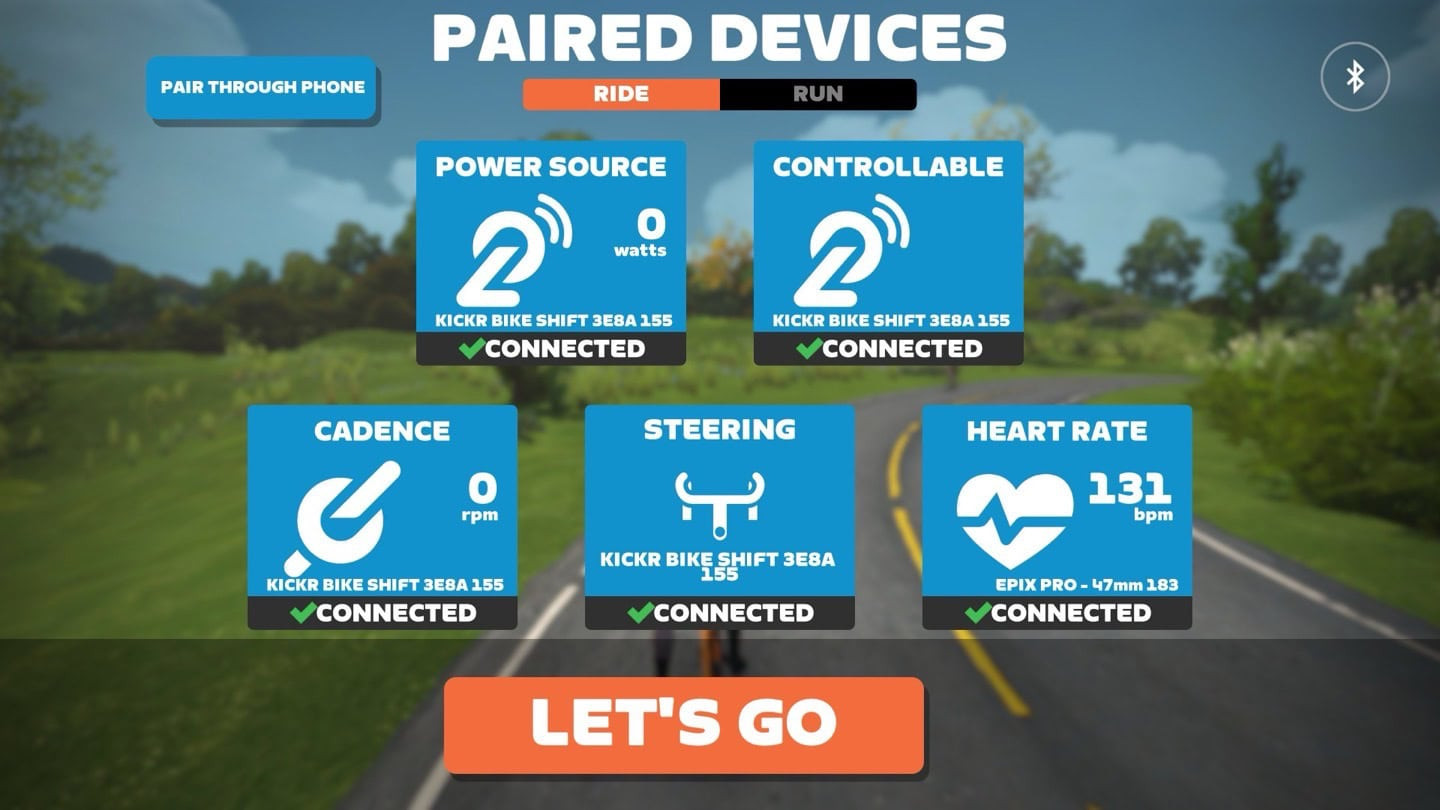 Pairing screen showing cadence sensor detected for KICKR BIKE SHIFT
Pairing screen showing cadence sensor detected for KICKR BIKE SHIFT
These standards also enable connectivity with bike head units. Wahoo and Garmin bike computers with ANT+ FE-C or Bluetooth Smart trainer control can be used to re-ride outdoor routes indoors.
Testing involved Zwift, IndieVelo, and TrainerRoad. Zwift and IndieVelo were used in both SIM and ERG modes, while TrainerRoad was used exclusively in ERG mode. Pairing in IndieVelo is shown below:
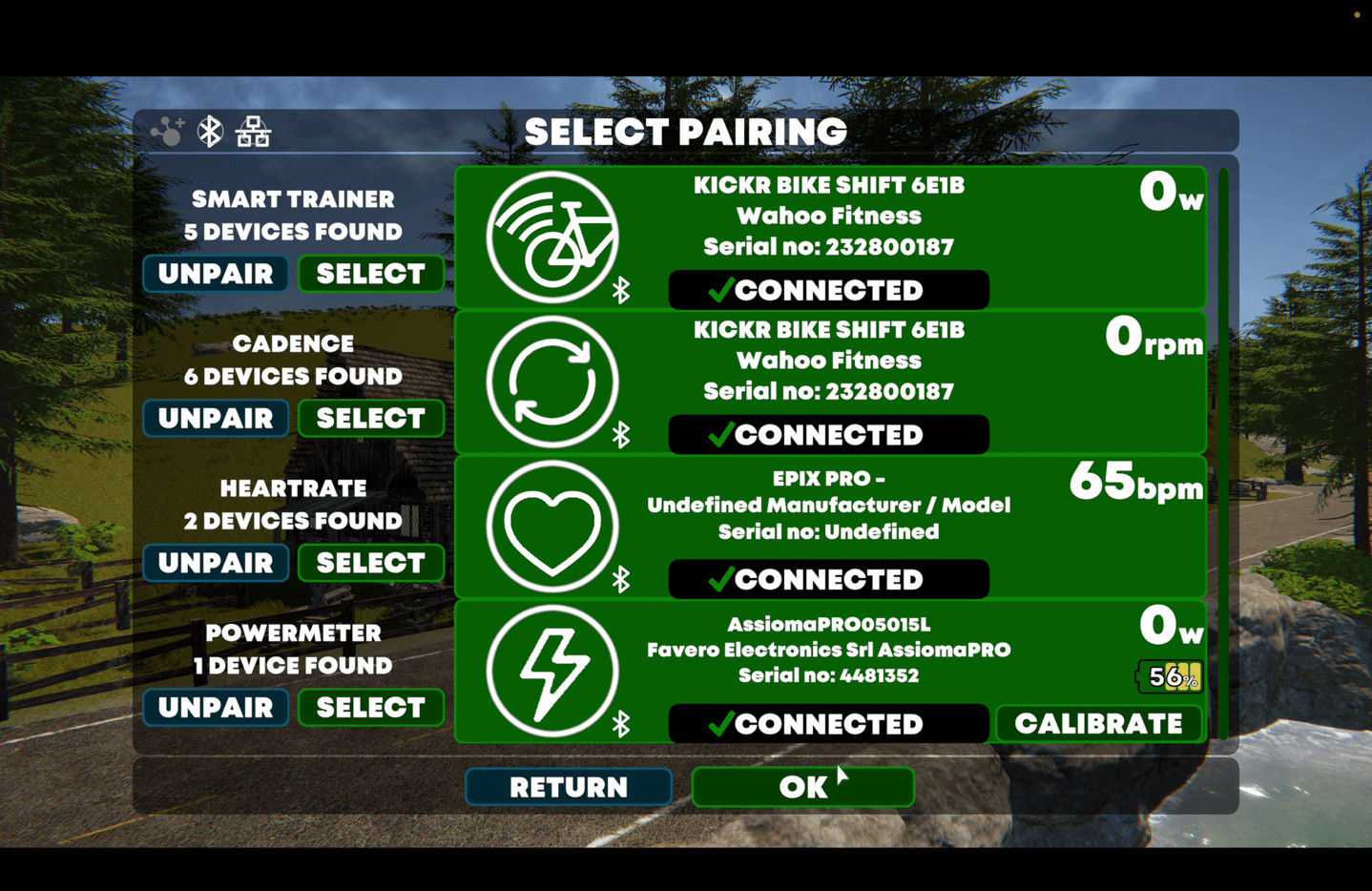 IndieVelo pairing screen with KICKR BIKE SHIFT recognized
IndieVelo pairing screen with KICKR BIKE SHIFT recognized
IndieVelo uniquely displays gearing information, unlike Zwift currently.
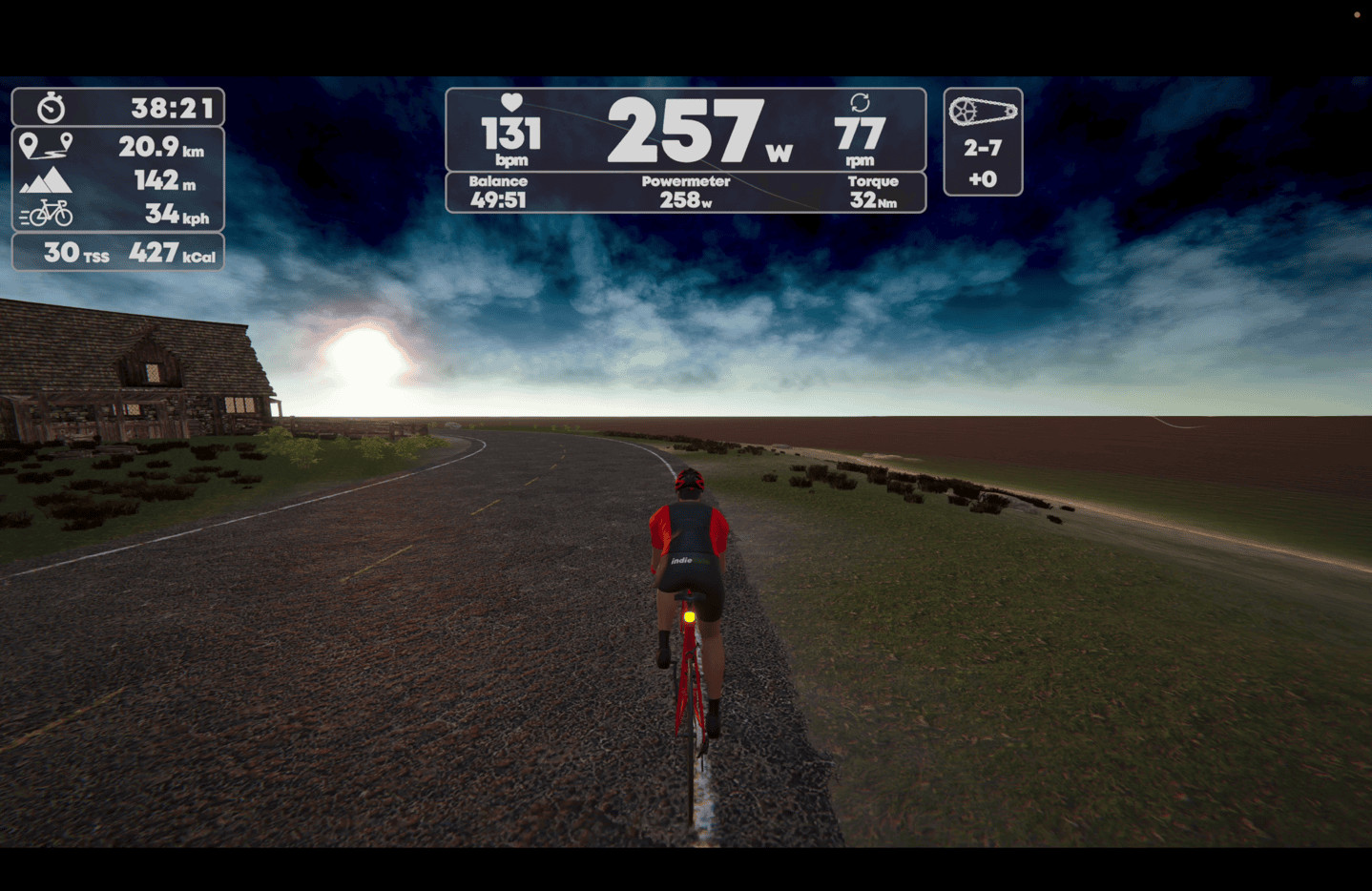 Gearing display in IndieVelo while riding the KICKR BIKE SHIFT
Gearing display in IndieVelo while riding the KICKR BIKE SHIFT
In Zwift, all core functionalities including shifting and steering work correctly, although gear display is pending. ERG mode functions as expected in Zwift:
 Zwift workout interface in ERG mode with KICKR BIKE SHIFT
Zwift workout interface in ERG mode with KICKR BIKE SHIFT
TrainerRoad integration in ERG mode was also flawless:
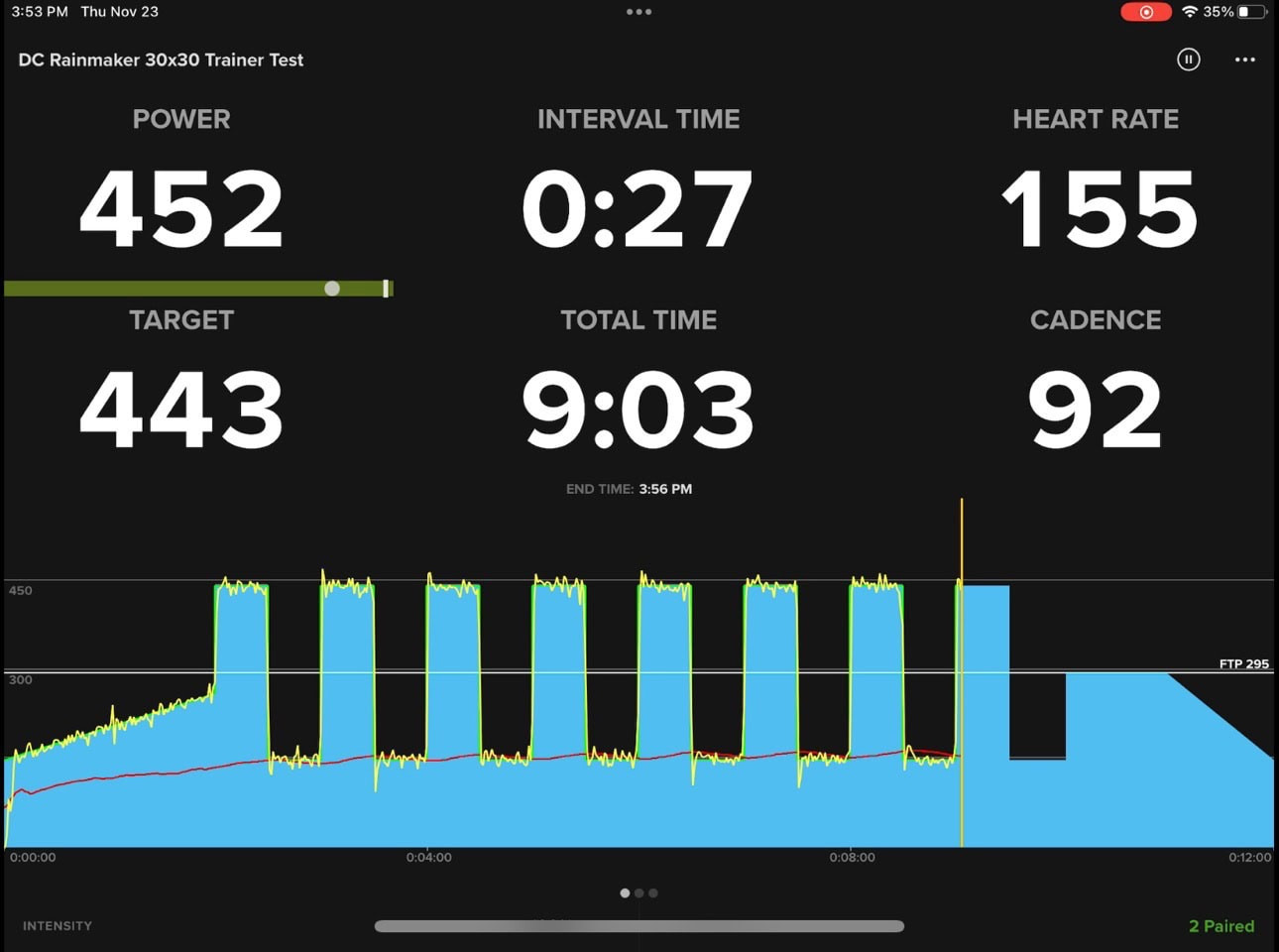 TrainerRoad workout interface with KICKR BIKE SHIFT in ERG mode
TrainerRoad workout interface with KICKR BIKE SHIFT in ERG mode
Zwift Play buttons were also tested and functioned seamlessly with the KICKR BIKE SHIFT, offering quick access to in-game functions.
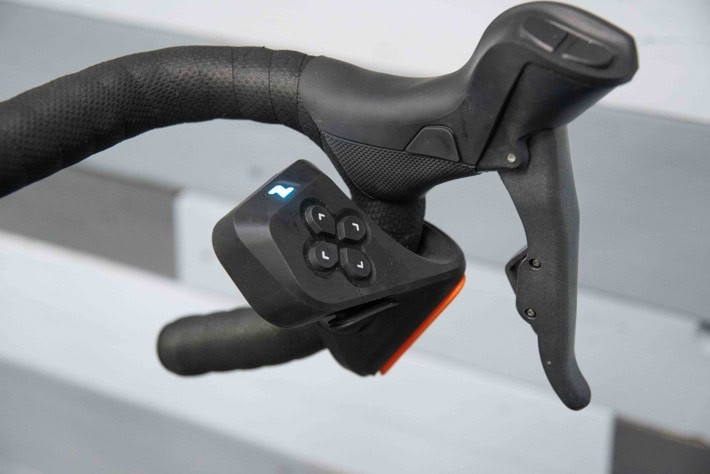 Close-up of Zwift Play button controls
Close-up of Zwift Play button controls
Power Accuracy: Now Precisely Tuned
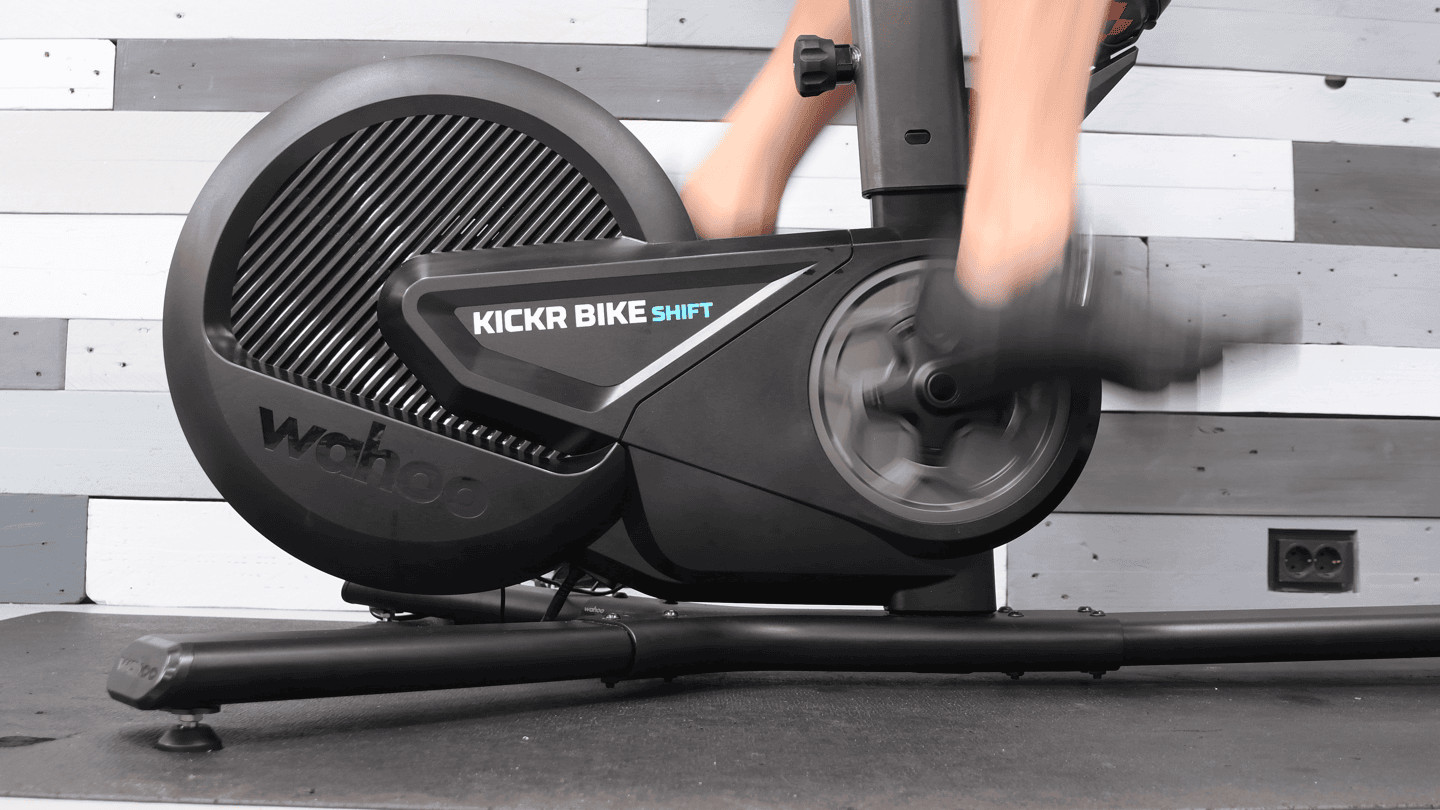 Close-up of the KICKR BIKE SHIFT resistance unit
Close-up of the KICKR BIKE SHIFT resistance unit
The extended review period is largely due to initial power accuracy concerns. Early firmware issues caused temperature compensation malfunctions, leading to inconsistent power readings. While initial issues were resolved, sporadic accuracy problems persisted for a period. However, since late November, subsequent software updates have stabilized performance.
Current testing focuses on comparing the KICKR BIKE SHIFT’s power readings against known-accurate power meters to assess resistance control accuracy, responsiveness, and identify any anomalies.
Responsiveness, while not directly accuracy, is crucial. It measures how quickly the bike reacts to workout commands, aiming for a 2-4 second response time for smooth transitions. Excessively rapid response feels jarring, while slow response can compromise interval training effectiveness.
30×30 interval tests were conducted in TrainerRoad to evaluate responsiveness and stability. The data shows the SHIFT consistently reaching target wattage within 3 seconds and maintaining stable power output:
 Responsiveness and stability data from TrainerRoad workout
Responsiveness and stability data from TrainerRoad workout
Power accuracy was then compared to Favero Assioma Duo power meter pedals, showing close agreement within a few watts:
 Accuracy comparison with Favero Assioma Duo pedals
Accuracy comparison with Favero Assioma Duo pedals
Longer ERG workouts, including further 30×30 intervals, against Favero Assioma MX2 Pro pedals, demonstrated exceptional consistency, often within 1-3 watts:
 Accuracy comparison in a longer ERG workout
Accuracy comparison in a longer ERG workout
Cadence readings also showed near-identical agreement.
Mean-max power curve comparisons further confirmed the close power data alignment, with differences often within just 3 watts across various power durations.
 Mean-max power curve comparison
Mean-max power curve comparison
In SIM mode workouts on Indievelo, including sprints, minor discrepancies appeared at peak 1-second power, with no consistent pattern favoring either the SHIFT or Favero pedals:
 Accuracy comparison during sprints in SIM mode
Accuracy comparison during sprints in SIM mode
Cadence accuracy in SIM mode remained consistent.
Mean-max power curves in SIM mode also showed close agreement.
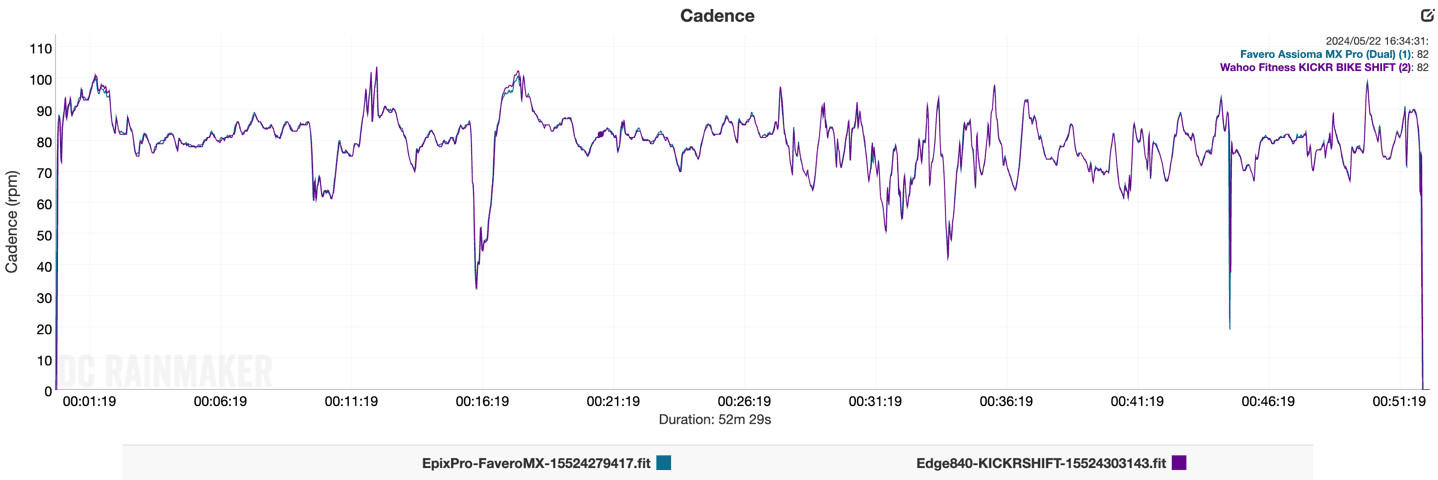 Mean-max power curve in SIM mode
Mean-max power curve in SIM mode
Further SIM mode workouts with sprints reinforced the close power tracking, generally within a few watts, considering transmission and recording timing variations.
 Accuracy during sprints in another SIM mode workout
Accuracy during sprints in another SIM mode workout
Cadence and mean-max power curves remained consistently accurate.
 Cadence accuracy in SIM mode workout
Cadence accuracy in SIM mode workout
In conclusion, despite initial accuracy issues, software updates have effectively resolved early teething problems with the KICKR BIKE SHIFT’s resistance unit. Current power accuracy, responsiveness, and stability are excellent and comparable to trusted power meter pedals.
Indoor Bike Comparison: Standing Out in the Market
The KICKR Bike SHIFT is compared against leading indoor bikes in the product comparison database, including the Wahoo KICKR Bike V2, Tacx NEO Bike Plus, and Wattbike ATOM 2020. The Stages SB20 is excluded due to Stages Cycling’s recent business closure. The comparison focuses on models personally tested.
| Function/Feature | Wahoo KICKR BIKE SHIFT | Wahoo KICKR Bike V2 | Tacx NEO Bike Plus | Wattbike ATOM 2020 |
|---|---|---|---|---|
| Price | $2,999 | $3,999 | $3,999 | $2,599 |
| Trainer Type | Indoor Bike | Indoor Bike | Indoor Bike | Indoor Bike |
| Availability | Yes | Yes | Yes | Yes |
| Resistance Control | Yes | Yes | Yes | Yes |
| Downhill Simulation | No | Yes | Yes | No |
| Max Wattage | 2,200w | 2,200w | 2,200w | 2,500w |
| Max Incline | 20% | 20% | 25% | 25% |
| Firmware Updates | Yes | Yes | Yes | Yes |
| Left/Right Power | No | No | Yes | Yes |
| Steering | Yes | Yes | Yes | Yes |
| Road Feel Simulation | No | No | Yes | No |
| Physical Gradient Simulation | No | Yes | No | No |
| Side-to-Side Rocking | No | No | No | No |
| Temp Compensation | Yes | Yes | N/A | Yes |
| Accuracy | +/- 1% | +/- 1% | +/- 1% | +/- 2% |
| 3rd Party Control | Yes | Yes | Yes | Yes |
| ANT+ FE-C | Yes | Yes | Yes | Yes |
| Bluetooth FTMS | Yes | Yes | Yes | Yes |
| WiFi/Ethernet | WiFi (Ethernet with accessory) | WIFI (ETHERNET WITH ACCESSORY) | No | No |
| Power Broadcast ANT+ | Yes | Yes | Yes | Yes |
| Power Broadcast Bluetooth | Yes | Yes | Yes | Yes |
| Concurrent Bluetooth | Yes, 3 | Yes, 3 | No, just one | Yes |
| Cadence Data | Yes | Yes | Yes | Yes |
| Race Mode | No | Yes | No | No |
| Shifting Type | Levers | Levers | Levers | Buttons |
| Customizable Shifting | Yes | Yes | Yes | No |
| Customizable Gearing | Yes | Yes | Yes | Yes |
| Crank Lengths | 165-175mm | 165-175mm | 170-175mm | 170mm |
| Display | No | Small display | Yes | No |
| USB Ports | No | 1 | 2 | No |
| Purchase Links | Link | Link | Link | Link |
| Review Link | Link | Link | Link | Link |
More bike comparisons, including the Mouv bike, are anticipated in future updates.
Final Verdict: Is the Wahoo Bike SHIFT Your Next Indoor Trainer?
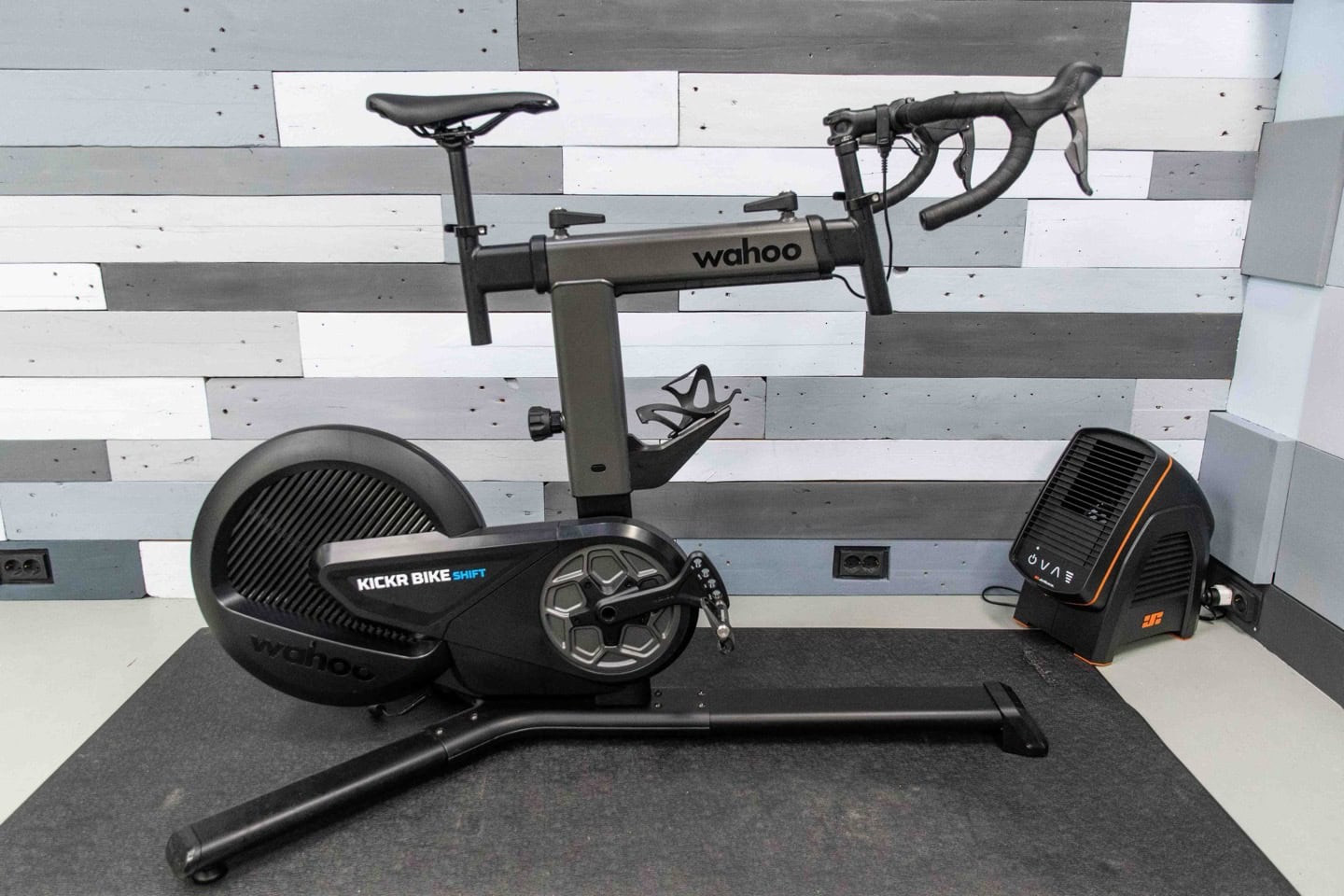 Angle view of the silent Wahoo KICKR BIKE SHIFT
Angle view of the silent Wahoo KICKR BIKE SHIFT
The indoor bike market offers a spectrum of options, ranging from excellent to subpar. The Wahoo KICKR BIKE SHIFT firmly resides in the “excellent” category, presenting a compelling package without the premium price of the KICKR BIKE V2. While lacking the physical incline/decline motion of the V2, the SHIFT arguably surpasses it in most other respects. Many KICKR Bike owners, including this reviewer, rarely utilize the CLIMB feature, making its absence a minor trade-off for the SHIFT’s advantages. The value proposition of the SHIFT is strong, especially considering the price difference. Similarly, KICKR Race Mode, while exclusive to the V2, will only be relevant to a small subset of users requiring ultra-high-speed data transmission.
Furthermore, the SHIFT’s design emphasizes durability and reduced maintenance. The KICKR BIKE V1, and many first-generation smart bikes, encountered hardware reliability issues. The V2 improved upon this, with Wahoo specifically focusing on hardware robustness. The SHIFT further refines this, minimizing moving parts and potential failure points, resulting in a robust and dependable system.
Long-term user feedback on the KICKR BIKE SHIFT has been largely positive, with most owners expressing satisfaction. While isolated hardware failures have been reported, their frequency appears significantly lower than with previous Wahoo bike generations. However, the absence of KICKR Race Mode on a $3,000 Wahoo bike, while present on a $1,200 Wahoo trainer, is a valid point of consideration for some users.
Ultimately, the Wahoo KICKR BIKE SHIFT is a strong contender in the indoor smart bike market. Its silent operation, robust build, accurate power, and user-friendly features make it a top choice. As the market evolves with new entrants, a comprehensive comparison post will be essential.
Support Our Site – Keep the Reviews Coming!
If you found this review helpful, please consider supporting our site! Your support enables us to create detailed, unbiased reviews. If you’re considering purchasing the Wahoo KICKR BIKE SHIFT or related accessories, using the affiliate links below helps support this website at no extra cost to you.
 Wahoo KICKR BIKE SHIFT transparent image for purchase links
Wahoo KICKR BIKE SHIFT transparent image for purchase links
Wahoo KICKR BIKE SHIFT
Explore these other Wahoo accessories to enhance your indoor cycling setup:
Wahoo Trainer Floor Mat
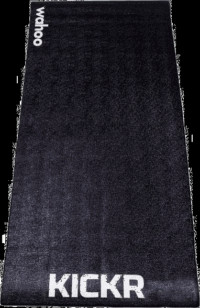 Wahoo Trainer Floor Mat transparent image
Wahoo Trainer Floor Mat transparent image
Amazon $80 Backcountry Competitive Cyclist REI $80
Wahoo Headwind Fan
Amazon $255 Backcountry $300 Competitive Cyclist $300 REI $300
Wahoo KICKR Desk
 Wahoo KICKR Desk transparent image
Wahoo KICKR Desk transparent image
Amazon $270 Backcountry $250 Competitive Cyclist $250
Essential Smart Bike Accessories:
Apple TV 4K
Basic Trainer Mat
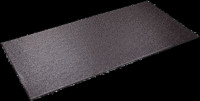 Basic Trainer Mat transparent image
Basic Trainer Mat transparent image
Elago R1 Apple TV Remote Silicone Case with Strap
 Apple TV Remote Case transparent image
Apple TV Remote Case transparent image
Honeywell HT-900 Fan
Lasko High Velocity Pro-Performance Fan (U15617)
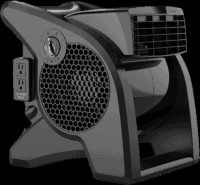 Lasko High Velocity Fan transparent image
Lasko High Velocity Fan transparent image
Indoor Cycle Trainer Desk (RAD/CXWXC/Vinsetto/Conquer/etc…)
KOM Cycling Trainer Desk
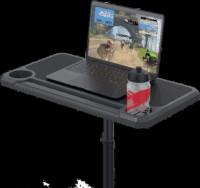 KOM Cycling Trainer Desk transparent image
KOM Cycling Trainer Desk transparent image
Thank you for reading! Please feel free to leave any questions or comments below.

